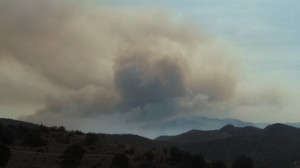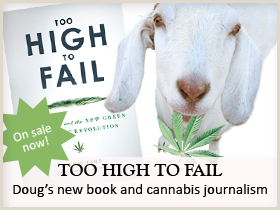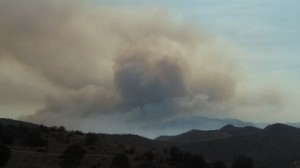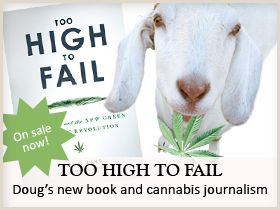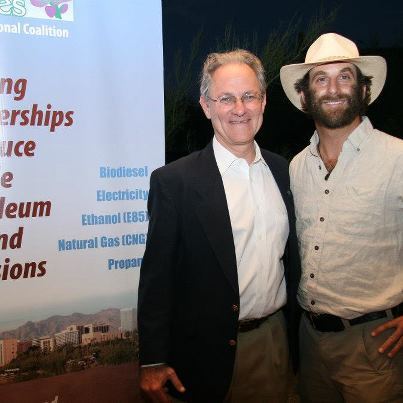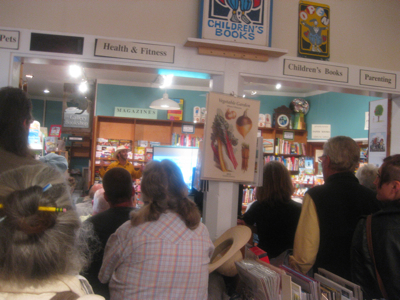Doug Fine's Blog, page 3
June 14, 2013
The Drug War’s Berlin Wall Is Down And So Is My Local Forest: Here’s The Connection
I’m on my yucca-framed porch swing sipping an organic Orange Julius and watching an 8,500-acre wildfire creep towards me here on the Funky Butte Ranch. Shrug. Just more climate change era chaos. I can smell and in fact feel the heat from the blaze already. Its light ash snowfall accumulating on my napping dog rather powerfully conveys the message that I’m on 41 acres surrounded by a huge ponderosa pine campfire eight miles away. My role is something like a putative marshmallow.
You can’t be a reader of these Dispatches and not realize that I’m at heart an optimist. Sure, my thinking goes, if general visibility decreases to below the official Forest Service benchmark level of “teacher’s lounge,” I will have to evacuate, for the sake of my human kids’ lungs (what to do with my goat kids is another question).
On the other hand, breakfasting to the sight of a massive smoke wall boiling over my eastern butte has a lot going for it. For one thing, how many times can one say one has so breakfasted? (It’d be my second climate change evacuation, actually, the last in Alaska 15 years ago.) Also, it vastly reassures me about having awakened today, rather than to the usual hummingbird wing alarm clock at the bedside window feeder, to an altogether more motorized aerial assault underway in my remote New Mexican valley.
This explanation was literally the bright side of potentially becoming a refugee; of temporarily abandoning the moment-to-moment silence I often describe as my health plan.
Readers of TOO HIGH TO FAIL will know why that is. It’s because the last time this many planes and choppers encircled my valley, it was to raid my AARP member neighbor for cultivating his own herbal medicine – about a dozen cannabis plants. This prior to the launch of New Mexico’s state medical cannabis program, which would today make my neighbor’s garden totally legal.
Forget about the hundreds of thousands of taxpayer dollars that went into that day’s cartel-ignoring Operation Annoy a Retiree Minding His Own Business. It was only the Drug War that brought automatic weapons (instead of the usual coyotes) to my riverbed, putting my family in danger. That, in fact, was what spurred me to write TOO HIGH TO FAIL, whose paperback release I’m now announcing. So to see federal aircraft employed for something other than Drug War assaults reinforces my feeling that we, the American people, are winning this one.
I’m remembering the research for the book, conducted from the front lines of North America’s longest war in 2011, with fondness. In examining a locavore approach to the post-Drug War economy in California’s famed Emerald Triangle, following small farmer efforts to brand themselves as Napa did with wine, I learned a lot about what sustainable family agriculture is. This (sustainable family agriculture) is the kind of industry you particularly tend to support when your homestead is imminently threatened by the “hundred year weather events” we seem to get on alternate Thursdays here in the Land of Enchantment these days.
Another way of saying this is that my final reflection on the irrefutable Drug Peace majority that has emerged nationwide and worldwide in the past year is: it will be terrific for the planet if the peace dividend from the end of the trillion dollar Drug War boondoggle includes putting independent, community-based farmers back in the field and sustainably bringing a multi-billion dollar industry aboveground. From what I’ve seen from Hawaii to North Dakota to Kentucky, America is ready.
I say this with confidence. I was far to the optimistic side of the punditsphere when, in TOO HIGH TO FAIL, I declared that the fall of the Drug War’s Berlin Wall was imminent. But I confess it seemed a no-brainer from the Emerald Triangle cannabis fields and strain development barns that I was studying. So as a result of stating the obvious (I mean, polls were already showing solid and growing majority support for medical cannabis in places like Kentucky, Illinois, Florida and Missouri) now I’ve become a go-to cannabis pundit because a producer can slam dunk a pitch with, “He predicted this.”
I’m not complaining. Forget about the heartland, the tipping point toward the Drug Peace now extends to the top of the old media hierarchy. I mean, you tell me. I would characterize the deciders at the Washington Post Company as accepting if not endorsing the inevitability of cannabis legalization by allowing me to publish this essay last Sunday entitled “Five Myths About Marijuana Legalization.” In fact, they assigned it.
I even got to talk about hemp in that ditty, which is what my next book, coming out later this year, is about. More on that in a future Dispatch. Same with my new syndicated Drug Peace Bumblebee column. One thing at a time.
And here’s the one thing at this time: I’d so love it if you’d use this note to help me launch the TOO HIGH TO FAIL paperback pre-order with flair. (Not Office Space flair. Stephen King pre-order flair.) I’d so appreciate it if you’d broadcast this missive through your social, professional and familial networks. The link to order is: http://www.amazon.com/Too-High-Fail-Cannabis-Revolution/dp/1592407617/ref=tmm_pap_title_0/192-9768244-4742452?ie=UTF8&qid=1330625413&sr=1-1
Specifically, I think it’ll take about 100,000 paperback pre-orders to convince my editors to issue a commemorative and forest-saving hemp edition of the book next. So you can help change policy while laughing at an in-the-field description of the Drug War’s final battles. Also there’s a fun new afterward in the paperback edition about the peace dividend we can look for when our worst policy since segregation finally ends. Seems like when a great nation makes its occasional blunder, it really goes for it. Gets it out of its system.
OK, thanks as always for your support. It’s so appreciated here on the possibly soon-to-combust Funky Butte Ranch. A strong launch helps me as a writer, but, more importantly, ending the Drug War will immediately have a direct impact on my life: It’ll keep automatic weapons out of the riverbed in which my children play.
Oh, yeah, the TOO HIGH TO FAIL paperback release live event tour is on. I’ll hit New Mexico first, then the Pacific Northwest and Arizona, then California. East Cost and Midwest dates are shaping up. Check out or book events at: http://dougfine.com/events/.
With more thanks than you can imagine, more thanks even than you might think necessary, but I believe there’s never too much appreciation,
Doug
Funky Butte Ranch, New Mexico
P.S. This Dispatch gives you a lot of opportunities to link to the Amazon page for TOO HIGH TO FAIL, including the e-version, and these are absolutely great, but I’d be remiss not to remind folks who live near actual bookstores (remember those?) that such are a terrific option also. And there’s Barnes and Noble and Books a Million, too.
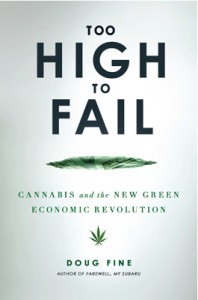
Click Cover Image to Order
TOO HIGH TO FAIL MEDIA
Conan O’Brien: http://dougfine.com/media-appearances/
New York Times: http://www.nytimes.com/2012/08/05/books/review/too-high-to-fail-by-doug-fine.html?_r=0
Washington Post: http://www.washingtonpost.com/opinions/five-myths-about-legalizing-marijuana/2013/06/07/9727eac4-c871-11e2-9f1a-1a7cdee20287_story.html
C-Span/Book TV: http://www.c-spanvideo.org/program/TooHi
Book Talk: http://www.mendocoasttv.org/CoastCurrents_23.html#featured
Daily Beast: http://www.thedailybeast.com/videos/2012/08/12/too-high-to-fail.html
MSNBC: http://tv.msnbc.com/2012/12/08/is-the-war-on-drugs-finally-going-to-pot/
Huffington Post Live: http://live.huffingtonpost.com/r/segment/506b11f002a76025c20003e7
Salon: http://www.salon.com/2012/11/01/marijuana_prohibition_hanging_by_a_thread/
BBC: http://www.bbc.co.uk/news/magazine-19336816
ReasonTV: http://www.youtube.com/watch?v=uI22wehAl7Y
Doug Fine’s DRUG PEACE BUMBLEBEE Column: Syndicated by Alternet, each week, the author of Too High to Fail pollinates the Drug Peace Message via meetings the world over with cannabis-friendly folks from all walks of life: http://nationalcannabiscoalition.com/2013/04/the-drug-peace-bumblebee/
REVIEWS OF DOUG FINE’S TOO HIGH TO FAIL
“Fine has written a well-researched book that uses the clever tactic of making the moral case for ending marijuana prohibition by burying it inside the economic case.” -Bill Maher in The New York Times
“Fine examines how the American people have borne the massive economic and social expenditures of the failed Drug War, which is ‘as unconscionably wrong for America as segregation and DDT.’ A captivating, solidly documented work rendered with wit and humor.” -Kirkus (Starred Review)
“A well-researched journey into the world of legal cannabis farming and a funny, maddening account of [American] farmers’ travails under federal persecution on an island of legality.” –Outside
“In his entertaining new book…(Fine) successfully illuminates an unusual world where cannabis growers sing ‘Happy Birthday’ to (friendly law enforcement) while crossing their fingers against the threat of federal raids. This informative book will give even hardened drug warriors pause.” -Publisher’s Weekly
“An important book.” -Michael Pollan

Click Cover Image to Order
The Drug War’s Berlin Wall Is Down And So Is My Local Forest: Here’s The Connection
I’m on my yucca-framed porch swing sipping an organic Orange Julius and watching an 8,500-acre wildfire creep towards me here on the Funky Butte Ranch. Shrug. Just more climate change era chaos. I can smell and in fact feel the heat from the blaze already. Its light ash snowfall accumulating on my napping dog rather powerfully conveys the message that I’m on 41 acres surrounded by a huge ponderosa pine campfire eight miles away. My role is something like a putative marshmallow.
You can’t be a reader of these Dispatches and not realize that I’m at heart an optimist. Sure, my thinking goes, if general visibility decreases to below the official Forest Service benchmark level of “teacher’s lounge,” I will have to evacuate, for the sake of my human kids’ lungs (what to do with my goat kids is another question).
On the other hand, breakfasting to the sight of a massive smoke wall boiling over my eastern butte has a lot going for it. For one thing, how many times can one say one has so breakfasted? (It’d be my second climate change evacuation, actually, the last in Alaska 15 years ago.) Also, it vastly reassures me about having awakened today, rather than to the usual hummingbird wing alarm clock at the bedside window feeder, to an altogether more motorized aerial assault underway in my remote New Mexican valley.
This explanation was literally the bright side of potentially becoming a refugee; of temporarily abandoning the moment-to-moment silence I often describe as my health plan.
Readers of TOO HIGH TO FAIL will know why that is. It’s because the last time this many planes and choppers encircled my valley, it was to raid my AARP member neighbor for cultivating his own herbal medicine – about a dozen cannabis plants. This prior to the launch of New Mexico’s state medical cannabis program, which would today make my neighbor’s garden totally legal.
Forget about the hundreds of thousands of taxpayer dollars that went into that day’s cartel-ignoring Operation Annoy a Retiree Minding His Own Business. It was only the Drug War that brought automatic weapons (instead of the usual coyotes) to my riverbed, putting my family in danger. That, in fact, was what spurred me to write TOO HIGH TO FAIL, whose paperback release I’m now announcing. So to see federal aircraft employed for something other than Drug War assaults reinforces my feeling that we, the American people, are winning this one.
I’m remembering the research for the book, conducted from the front lines of North America’s longest war in 2011, with fondness. In examining a locavore approach to the post-Drug War economy in California’s famed Emerald Triangle, following small farmer efforts to brand themselves as Napa did with wine, I learned a lot about what sustainable family agriculture is. This (sustainable family agriculture) is the kind of industry you particularly tend to support when your homestead is imminently threatened by the “hundred year weather events” we seem to get on alternate Thursdays here in the Land of Enchantment these days.
Another way of saying this is that my final reflection on the irrefutable Drug Peace majority that has emerged nationwide and worldwide in the past year is: it will be terrific for the planet if the peace dividend from the end of the trillion dollar Drug War boondoggle includes putting independent, community-based farmers back in the field and sustainably bringing a multi-billion dollar industry aboveground. From what I’ve seen from Hawaii to North Dakota to Kentucky, America is ready.
I say this with confidence. I was far to the optimistic side of the punditsphere when, in TOO HIGH TO FAIL, I declared that the fall of the Drug War’s Berlin Wall was imminent. But I confess it seemed a no-brainer from the Emerald Triangle cannabis fields and strain development barns that I was studying. So as a result of stating the obvious (I mean, polls were already showing solid and growing majority support for medical cannabis in places like Kentucky, Illinois, Florida and Missouri) now I’ve become a go-to cannabis pundit because a producer can slam dunk a pitch with, “He predicted this.”
I’m not complaining. Forget about the heartland, the tipping point toward the Drug Peace now extends to the top of the old media hierarchy. I mean, you tell me. I would characterize the deciders at the Washington Post Company as accepting if not endorsing the inevitability of cannabis legalization by allowing me to publish this essay last Sunday entitled “Five Myths About Marijuana Legalization.” In fact, they assigned it.
I even got to talk about hemp in that ditty, which is what my next book, coming out later this year, is about. More on that in a future Dispatch. Same with my new syndicated Drug Peace Bumblebee column. One thing at a time.
And here’s the one thing at this time: I’d so love it if you’d use this note to help me launch the TOO HIGH TO FAIL paperback pre-order with flair. (Not Office Space flair. Stephen King pre-order flair.) I’d so appreciate it if you’d broadcast this missive through your social, professional and familial networks. The link to order is: http://www.amazon.com/Too-High-Fail-Cannabis-Revolution/dp/1592407617/ref=tmm_pap_title_0/192-9768244-4742452?ie=UTF8&qid=1330625413&sr=1-1
Specifically, I think it’ll take about 100,000 paperback pre-orders to convince my editors to issue a commemorative and forest-saving hemp edition of the book next. So you can help change policy while laughing at an in-the-field description of the Drug War’s final battles. Also there’s a fun new afterward in the paperback edition about the peace dividend we can look for when our worst policy since segregation finally ends. Seems like when a great nation makes its occasional blunder, it really goes for it. Gets it out of its system.
OK, thanks as always for your support. It’s so appreciated here on the possibly soon-to-combust Funky Butte Ranch. A strong launch helps me as a writer, but, more importantly, ending the Drug War will immediately have a direct impact on my life: It’ll keep automatic weapons out of the riverbed in which my children play.
Oh, yeah, the TOO HIGH TO FAIL paperback release live event tour is on. I’ll hit New Mexico first, then the Pacific Northwest and Arizona, then California. East Cost and Midwest dates are shaping up. Check out or book events at: http://www.dougfine.com/events/.
With more thanks than you can imagine, more thanks even than you might think necessary, but I believe there’s never too much appreciation,
Doug
Funky Butte Ranch, New Mexico
P.S. This Dispatch gives you a lot of opportunities to link to the Amazon page for TOO HIGH TO FAIL, including the e-version, and these are absolutely great, but I’d be remiss not to remind folks who live near actual bookstores (remember those?) that such are a terrific option also. And there’s Barnes and Noble and Books a Million, too.
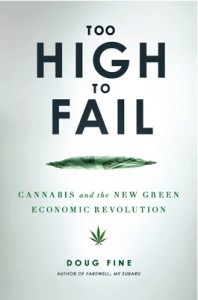
Click Cover Image to Order
TOO HIGH TO FAIL MEDIA
Conan O’Brien: http://www.dougfine.com/media-appearances/
New York Times: http://www.nytimes.com/2012/08/05/books/review/too-high-to-fail-by-doug-fine.html?_r=0
Washington Post: http://www.washingtonpost.com/opinions/five-myths-about-legalizing-marijuana/2013/06/07/9727eac4-c871-11e2-9f1a-1a7cdee20287_story.html
C-Span/Book TV: http://www.c-spanvideo.org/program/TooHi
Book Talk: http://www.mendocoasttv.org/CoastCurrents_23.html#featured
Daily Beast: http://www.thedailybeast.com/videos/2012/08/12/too-high-to-fail.html
MSNBC: http://tv.msnbc.com/2012/12/08/is-the-war-on-drugs-finally-going-to-pot/
Huffington Post Live: http://live.huffingtonpost.com/r/segment/506b11f002a76025c20003e7
Salon: http://www.salon.com/2012/11/01/marijuana_prohibition_hanging_by_a_thread/
BBC: http://www.bbc.co.uk/news/magazine-19336816
ReasonTV: http://www.youtube.com/watch?v=uI22wehAl7Y
Doug Fine’s DRUG PEACE BUMBLEBEE Column: Syndicated by Alternet, each week, the author of Too High to Fail pollinates the Drug Peace Message via meetings the world over with cannabis-friendly folks from all walks of life: http://nationalcannabiscoalition.com/2013/04/the-drug-peace-bumblebee/
REVIEWS OF DOUG FINE’S TOO HIGH TO FAIL
“Fine has written a well-researched book that uses the clever tactic of making the moral case for ending marijuana prohibition by burying it inside the economic case.” -Bill Maher in The New York Times
“Fine examines how the American people have borne the massive economic and social expenditures of the failed Drug War, which is ‘as unconscionably wrong for America as segregation and DDT.’ A captivating, solidly documented work rendered with wit and humor.” -Kirkus (Starred Review)
“A well-researched journey into the world of legal cannabis farming and a funny, maddening account of [American] farmers’ travails under federal persecution on an island of legality.” –Outside
“In his entertaining new book…(Fine) successfully illuminates an unusual world where cannabis growers sing ‘Happy Birthday’ to (friendly law enforcement) while crossing their fingers against the threat of federal raids. This informative book will give even hardened drug warriors pause.” -Publisher’s Weekly
“An important book.” -Michael Pollan

Click Cover Image to Order
May 28, 2013
The Drug Peace Bumblebee Column Debuts
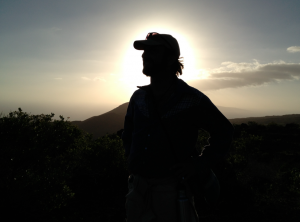 Best-selling author Doug Fine spreads his Drug Peace ideals each week via the Drug Peace Bumblebee. (Photo by Michael Bowman)
Best-selling author Doug Fine spreads his Drug Peace ideals each week via the Drug Peace Bumblebee. (Photo by Michael Bowman)
I’m delighted to announce a new weekly column I’m writing for the National Cannabis Coalition which is being syndicated by Alternet. Here’s the premise, as reflected in the column bio. I welcome column suggestions from anywhere on the planet:
About Doug Fine
Doug Fine, bestselling author of Too High to Fail: Cannabis and the New Green Economic Revolution and Farewell, My Subaru, is not just a comedic sustainability author but one of the world’s few investigative cannabis journalists. As such, he meets folks from Hawaii to Laos who, until federal and worldwide prohibition finally ends and the professional conventions begin, are unlikely to meet one another. He’s a pollinator of Drug Peace ideas, in other words, a bumblebee. Each week in this column you’ll hear another cannabis story from around the planet. Doug’s work from five continents is at: www.dougfine.com. Follow him on Twitter and on Facebook.
Here’s the debut column:
PTSD Treatment Special Delivery: CBD Giveaway to Veterans
As he prepared to distribute the first of 100,000 specialized cannabis seedlings in a limo once owned by Ferdinand Marcos, the last thing Denver’s Bill Althouse was worried about was money. This is important, since the debut of his “Free For All” cannabis delivery project, which he invited me to witness on a recent early spring afternoon, hinged on gratis distribution.
“You’re in sync with (Colorado’s cannabis-legalizing) Amendment 64 if you give it away,” the 61-year-old engineer told me as, without fanfare, he launched what he considers to be a landmark project that is part humanitarian outreach and part viable scientific field research.
No, Althouse is not one of the venture capitalists poised to profit from the end of the Drug War. His priorities are closer to those of sourdough starter. Only instead of bread, what he was delivering in his vegetable oil-powered limo this chilly day was a mother plant that had tested high in a non-psychoactive cannabinoid (component of the cannabis plant) known as cannabidiol, or CBD.
Althouse recognized from personal experimentation that high-CBD cannabis strains have helped dramatically ease his own PTSD symptoms. So, with Colorado’s 2012 legalization of adult use of cannabis, Althouse relocated to the Rocky Mountain State because he’d come up with a plan to help other sufferers.
“The idea is to deliver CBD-rich cannabis plants across Colorado, and let the cloning and healing begin,” he told me in the upscale Denver outskirt of Lakeland. He was struggling down his front yard path while clutching a bushy, deep green cannabis plant. “And for people who are already healthy adults, study after study shows CBD to be a cancer fighting tool, part of any adult’s health maintenance regimen. You should be throwing the flowers from this lady in your morning shake.”
The strain Althouse had chosen to distribute is called Harlequin. The mother plant I was now watching him stuff into the back seat of the limo (we’ll call her Rebecca) tested at eight percent CBD (and three percent THC, the psychoactive and thus most famous of the 90 known cannabinoids).
Now, I learned in our first hour together that Althouse could cite dozens of studies from around the world that confirm CBD’s health benefits in areas far beyond the psychiatric. In fact, I heard about (and later confirmed) studies that showed promise in areas ranging from pain reduction to mood elevation to tumor cytotoxicity (cancer cell destruction). One example that’s received a lot of attention is a 2010 study by researchers at the California Pacific Medical Center that showed rodent breast cancer cells wiped out by CBD.
But because even he acknowledged that cannabinoid research is in his infancy (thank you, Drug War), Althouse wants to see the Free For All distribution provide baseline data for what is in effect a massive scale field study into CBD’s mental health benefits.
“Because of the thousands of lives torn apart by legal psychotropic pharmaceuticals, I’m going to encourage Free For All participants to be part of growing the CBD database,” Althouse told me as he hopped into the 1979 Mercerdes stretch. Whether or not this massive, cream-colored pleasure conveyance had its sheepskin seat covers installed by a Filipino dictator (this I couldn’t confirm, but everything else Althouse told me was true), I saw right away that this was going to be the most comfortable journalistic ride I’d ever enjoyed. The suspension alone was like a massage.
Yes, at least he would be making his deliveries in style. Displaying a profound understanding of media relations, Althouse played chauffeur and sat me down a mile back on a sofa next to the Rebecca. About half my size, she sat in her five-gallon pot, waving at me with every pothole while a light snow sent confetti flakes around me outside.
As we shot out into Mile High Traffic, I couldn’t fully hear him until I told him to speak up, since Althouse at first didn’t recognize how loudly he had to shout for sound to reach me in the different county that I occupied on the limo’s rear couch. But eventually I grasped that he was explaining his theory about why CBD-rich cannabis plants were likely to work well for PTSD symptom mitigation – or even syndrome recovery.
“If you’ve got anxiety issues to begin with, a lower THC level – not a negligible one, but a lower one – combined with the high CBD is probably what you’re looking for. When the data are in, we might see it turn out be a cannabinoid ratio issue, like we see with Omega fatty acids in our diet.”
His choice of first Free For All delivery was a no brainer for Althouse, the kind of guy who can make himself look ready to give a presentation to venture capitalists (or the AMA), but usually chooses not to. Turns out there was an Iraq veteran friend of his, Tim, who might benefit from, well, anything non-pharmaceutical that could help with some of the PTSD-related issues that are wreaking havoc in his post-service life.
“If it works, it could help me get my life back,” the goateed, 30-something Tim told me when we arrived at his Colorado Springs home. He said I could use his real name, but, speaking in an incredibly open manner that reflected his desperation, he was so dang forthcoming in the hour we chatted that I thought it better to not cause him to regret that decision.
“The pharmaceuticals I’ve been given are basically torture,” Tim told me at his kitchen table. “I spent a month without seeing daylight at one point. I’ve been a zombie.”
He pointed at a stack of nearby disk golf Frisbees. “I want to be out doing that again.” Then he pointed to an even nearer weekly pill box. “Not that.”
This echoed the tale of pain and PTSD medication woe I’d heard from many veterans in the course of my research for my recent book about the coming Drug Peace economy, Too High to Fail: Cannabis and the New Green Economic Revolution.
And yet it struck Althouse as he fired the Marcos-mobile up for the return ride, that the health maintenance promise of CBD might have the widest impact on overall American health care costs as the Drug Peace Era begins. After all, he pointed out, healthy living has long been documented as the best way to keep medical expenses down. If Americans substitute cannabis for the immensely dangerous and expensive-to-society alcohol in social situations, he believes we’re likely to see tens of millions saved in the public safety sphere.
“I see CBD as a nutritional supplement,” my chauffeur told me. “In Colorado and Washington, people no longer have to wait to get sick before they can benefit from it.”
Before we’d left Tim’s house, Althouse had hauled the well-coddled Rebecca from the limo to Tim’s kitchen. There, they clipped and transplanted two seedlings. The Free For All plan is one of those “then I told two friends, and they told two” viral efforts that Althouse hopes will bring millions of Rebecca plants into American lives.
Inside Tim’s house, the hopes were more personal. “It’d be nice to have my husband back,” Tim’s wife told me as we said goodbye. Tim was standing right next to her, nodding.
For more information on Althouse’s Free For All project, contact info@cannatech.coop.
Postscript for readers of the Dispatches From the Funky Butte Ranch: We’re four columns in as of this posting. You can check out the new Drug Peace Bumblebee every week at: http://nationalcannabiscoalition.com/
The Drug Peace Bumblebee Column Debuts
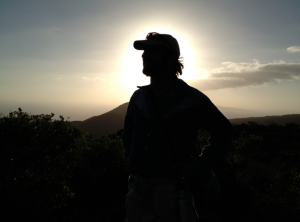 Best-selling author Doug Fine spreads his Drug Peace ideals each week via the Drug Peace Bumblebee. (Photo by Michael Bowman)
Best-selling author Doug Fine spreads his Drug Peace ideals each week via the Drug Peace Bumblebee. (Photo by Michael Bowman)
I’m delighted to announce a new weekly column I’m writing for the National Cannabis Coalition which is being syndicated by Alternet. Here’s the premise, as reflected in the column bio. I welcome column suggestions from anywhere on the planet:
About Doug Fine
Doug Fine, bestselling author of Too High to Fail: Cannabis and the New Green Economic Revolution and Farewell, My Subaru, is not just a comedic sustainability author but one of the world’s few investigative cannabis journalists. As such, he meets folks from Hawaii to Laos who, until federal and worldwide prohibition finally ends and the professional conventions begin, are unlikely to meet one another. He’s a pollinator of Drug Peace ideas, in other words, a bumblebee. Each week in this column you’ll hear another cannabis story from around the planet. Doug’s work from five continents is at: www.dougfine.com. Follow him on Twitter and on Facebook.
Here’s the debut column:
PTSD Treatment Special Delivery: CBD Giveaway to Veterans
As he prepared to distribute the first of 100,000 specialized cannabis seedlings in a limo once owned by Ferdinand Marcos, the last thing Denver’s Bill Althouse was worried about was money. This is important, since the debut of his “Free For All” cannabis delivery project, which he invited me to witness on a recent early spring afternoon, hinged on gratis distribution.
“You’re in sync with (Colorado’s cannabis-legalizing) Amendment 64 if you give it away,” the 61-year-old engineer told me as, without fanfare, he launched what he considers to be a landmark project that is part humanitarian outreach and part viable scientific field research.
No, Althouse is not one of the venture capitalists poised to profit from the end of the Drug War. His priorities are closer to those of sourdough starter. Only instead of bread, what he was delivering in his vegetable oil-powered limo this chilly day was a mother plant that had tested high in a non-psychoactive cannabinoid (component of the cannabis plant) known as cannabidiol, or CBD.
Althouse recognized from personal experimentation that high-CBD cannabis strains have helped dramatically ease his own PTSD symptoms. So, with Colorado’s 2012 legalization of adult use of cannabis, Althouse relocated to the Rocky Mountain State because he’d come up with a plan to help other sufferers.
“The idea is to deliver CBD-rich cannabis plants across Colorado, and let the cloning and healing begin,” he told me in the upscale Denver outskirt of Lakeland. He was struggling down his front yard path while clutching a bushy, deep green cannabis plant. “And for people who are already healthy adults, study after study shows CBD to be a cancer fighting tool, part of any adult’s health maintenance regimen. You should be throwing the flowers from this lady in your morning shake.”
The strain Althouse had chosen to distribute is called Harlequin. The mother plant I was now watching him stuff into the back seat of the limo (we’ll call her Rebecca) tested at eight percent CBD (and three percent THC, the psychoactive and thus most famous of the 90 known cannabinoids).
Now, I learned in our first hour together that Althouse could cite dozens of studies from around the world that confirm CBD’s health benefits in areas far beyond the psychiatric. In fact, I heard about (and later confirmed) studies that showed promise in areas ranging from pain reduction to mood elevation to tumor cytotoxicity (cancer cell destruction). One example that’s received a lot of attention is a 2010 study by researchers at the California Pacific Medical Center that showed rodent breast cancer cells wiped out by CBD.
But because even he acknowledged that cannabinoid research is in his infancy (thank you, Drug War), Althouse wants to see the Free For All distribution provide baseline data for what is in effect a massive scale field study into CBD’s mental health benefits.
“Because of the thousands of lives torn apart by legal psychotropic pharmaceuticals, I’m going to encourage Free For All participants to be part of growing the CBD database,” Althouse told me as he hopped into the 1979 Mercerdes stretch. Whether or not this massive, cream-colored pleasure conveyance had its sheepskin seat covers installed by a Filipino dictator (this I couldn’t confirm, but everything else Althouse told me was true), I saw right away that this was going to be the most comfortable journalistic ride I’d ever enjoyed. The suspension alone was like a massage.
Yes, at least he would be making his deliveries in style. Displaying a profound understanding of media relations, Althouse played chauffeur and sat me down a mile back on a sofa next to the Rebecca. About half my size, she sat in her five-gallon pot, waving at me with every pothole while a light snow sent confetti flakes around me outside.
As we shot out into Mile High Traffic, I couldn’t fully hear him until I told him to speak up, since Althouse at first didn’t recognize how loudly he had to shout for sound to reach me in the different county that I occupied on the limo’s rear couch. But eventually I grasped that he was explaining his theory about why CBD-rich cannabis plants were likely to work well for PTSD symptom mitigation – or even syndrome recovery.
“If you’ve got anxiety issues to begin with, a lower THC level – not a negligible one, but a lower one – combined with the high CBD is probably what you’re looking for. When the data are in, we might see it turn out be a cannabinoid ratio issue, like we see with Omega fatty acids in our diet.”
His choice of first Free For All delivery was a no brainer for Althouse, the kind of guy who can make himself look ready to give a presentation to venture capitalists (or the AMA), but usually chooses not to. Turns out there was an Iraq veteran friend of his, Tim, who might benefit from, well, anything non-pharmaceutical that could help with some of the PTSD-related issues that are wreaking havoc in his post-service life.
“If it works, it could help me get my life back,” the goateed, 30-something Tim told me when we arrived at his Colorado Springs home. He said I could use his real name, but, speaking in an incredibly open manner that reflected his desperation, he was so dang forthcoming in the hour we chatted that I thought it better to not cause him to regret that decision.
“The pharmaceuticals I’ve been given are basically torture,” Tim told me at his kitchen table. “I spent a month without seeing daylight at one point. I’ve been a zombie.”
He pointed at a stack of nearby disk golf Frisbees. “I want to be out doing that again.” Then he pointed to an even nearer weekly pill box. “Not that.”
This echoed the tale of pain and PTSD medication woe I’d heard from many veterans in the course of my research for my recent book about the coming Drug Peace economy, Too High to Fail: Cannabis and the New Green Economic Revolution.
And yet it struck Althouse as he fired the Marcos-mobile up for the return ride, that the health maintenance promise of CBD might have the widest impact on overall American health care costs as the Drug Peace Era begins. After all, he pointed out, healthy living has long been documented as the best way to keep medical expenses down. If Americans substitute cannabis for the immensely dangerous and expensive-to-society alcohol in social situations, he believes we’re likely to see tens of millions saved in the public safety sphere.
“I see CBD as a nutritional supplement,” my chauffeur told me. “In Colorado and Washington, people no longer have to wait to get sick before they can benefit from it.”
Before we’d left Tim’s house, Althouse had hauled the well-coddled Rebecca from the limo to Tim’s kitchen. There, they clipped and transplanted two seedlings. The Free For All plan is one of those “then I told two friends, and they told two” viral efforts that Althouse hopes will bring millions of Rebecca plants into American lives.
Inside Tim’s house, the hopes were more personal. “It’d be nice to have my husband back,” Tim’s wife told me as we said goodbye. Tim was standing right next to her, nodding.
For more information on Althouse’s Free For All project, contact info@cannatech.coop.
Postscript for readers of the Dispatches From the Funky Butte Ranch: We’re four columns in as of this posting. You can check out the new Drug Peace Bumblebee every week at: http://nationalcannabiscoalition.com/
April 5, 2013
The View Eighteen Degrees to My Left
Even Though a Majority Favor the Drug Peace in My Own New Mexico (As We Do Nationwide), What I’m Noticing in Interviews Like This Terrifically Thorough Half-hour One With the Land of Enchantment PBS Affiliate’s “Newsmakers” Program, Is That The Most Most Mainstream of U.S. Media Platforms Take My “Ending the Drug War is Inevitable and Good” Premise For Granted
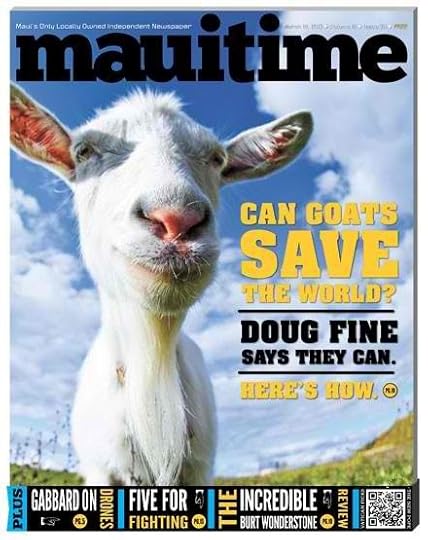
I Would Still Love Hawaii Even If It’s Denizens Hadn’t Been So Nice to Me
My son just burst into my office (trailing a dripping water balloon in each hand that served the same purpose as a medieval bugle volley) to suggest that it was high time I hung one of our blown glass hummingbird feeders outside this window where I spend so much time. The first wave of the only creatures I’ve met with a faster metabolism than my own had been back from their Costa Rican vacation for nearly three days, was his basic point. Their silky, spider web-cushioned doughnut nests were already starting to rise in the usual cholla cactus cradles.
It was, as anyone serenaded, let alone stared-down, by a hovering hummingbird knows, not a bad suggestion. I explained to my replicant that I hadn’t been rushing the washing, filling and mounting of the violet, conical feeder I favor (itself a magnificent work of art, the second purchased from the artist at Oregon Country Fair), primarily because plenty of hummingbirds had been visiting my windowsill already. Heaving deeply from chests the size of wristwatch faces, they appeared grateful just to get a break from the buzzy feeding frenzy running 18 hours a day at every other corner of the adobe Funky Butte Ranch house.
But I also told him that part of the reason for my patience (one man’s laziness) is that, as the ecosystem currently stood here in the high desert spring, I saw just enough deer, quail and strange cats sipping at the graywater laundry runoff creek that happens to materialize at eye level the moment I look left away from my laptop, to keep me on the good side of distracted. Recent studies, I homeschooled, reveal that we need to empty our thinking mind periodically to allow space for constant neural innovation. For me “periodically” means “pretty dang often.”
In the end, this “Eighteen Degrees to My Screen’s Left” viewshed might be the greatest single influence on my writing during this Land of Enchantment phase of my life. Upon these now five minutes of reflection, I see that there’s almost no way the addition of a few dozen ruby-throated and rufous hummingbirds per hour would be a detriment to the (to put it mildly) inspirational vibe that I enjoy in my work space.
I actually have laundry runoff on my mind at the moment for another reason, long-shot though that statement reasonably seems. In fact I’ve just been writing about how hemp-based Doctor Bronner’s laundry soap recently won a sustainable wash-off. If you’ve already checked out Too High to Fail you can read about this in my forthcoming hemp ebook for the folks at TED – more on that including release date in the next Dispatch. To be among the first to hear the details, you can follow me on Twitter.
The three months of in-the-field research for that project comprised a journey to places pleasant (Hawaii in January) and (on-paper) less so (Manitoba in February). It resulted in adventures including enjoying a hemp-powered limo ride in Denver, testifying for the Drug peace Era in Hawaii, and discovering farmer who powers his farm and town from a carbon-neutral personal hemp power plant.
I’m extremely excited (OK, as I always am when finishing a project) about how this one turned out, in this case because it’s my first multimedia ebook. When I first started out as an author, I could only dream that I would one day be unleashed to simultaneously tell a single story in word and image. I thought I’d have a book side and a film side. Which is to say, this project is a classic case of one that had me feeling lucky to be a professional question-asker.
OK, off to cook some hummingbird juice. Have you any idea how much it means to me that my not-yet-five-year-old offspring (at the moment watering our blossoming orchard) thinks and cares about my work day aesthetics?
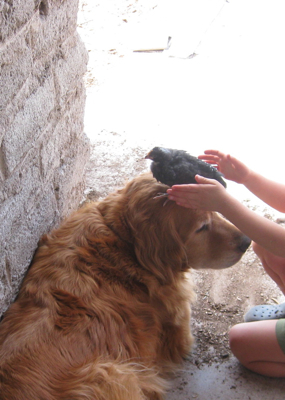
Even With a Mountain Lion Treating My Chickens Like a Take-Out Buffet, I Can Run Up My Canyon Again Thanks to the New Funky Butte Ranch Dog: Meet Golden (Mutual) Rescue Abbie
April 4, 2013
The View Eighteen Degrees to My Left
Even Though a Majority Favor the Drug Peace in My Own New Mexico (As We Do Nationwide), What I’m Noticing in Interviews Like This Terrifically Thorough Half-hour One With the Land of Enchantment PBS Affiliate’s “Newsmakers” Program, Is That The Most Most Mainstream of U.S. Media Platforms Take My “Ending the Drug War is Inevitable and Good” Premise For Granted
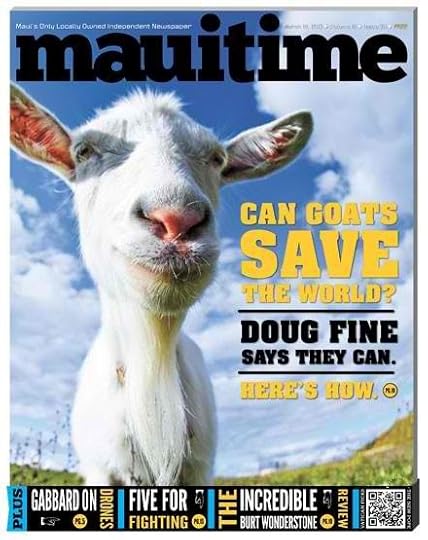
I Would Still Love Hawaii If It’s Denizens Hadn’t Been So Nice to Me
My son just burst into my office (trailing a dripping water balloon in each hand that served the same purpose as a medieval bugle volley) to suggest that it was high time I hung one of our blown glass hummingbird feeders outside this window where I spend so much time. The first wave of the only creatures I’ve met with a faster metabolism than my own had been back from their Costa Rican vacation for nearly three days, was his basic point. Their silky, spider web-cushioned doughnut nests were already starting to rise in the usual cholla cactus cradles.
It was, as anyone serenaded, let alone stared-down, by a hovering hummingbird knows, not a bad suggestion. I explained to my replicant that I hadn’t been rushing the washing, filling and mounting of the violet, conical feeder I favor (itself a magnificent work of art, the second purchased from the artist at Oregon Country Fair), primarily because plenty of hummingbirds had been visiting my windowsill, grateful just to get a break from the buzzy feeding frenzy running 18 hours a day at every other corner of the adobe Funky Butte Ranch house.
But I also told him that part of the reason for my patience (one man’s laziness) is that, as the ecosystem currently stood here in the high desert spring, I saw just enough deer, quail and strange cats sipping at the graywater laundry runoff creek that happens to materialize at eye level the moment I look left away from my laptop, to keep me on the good side of distracted. Recent studies, I homeschooled, reveal that we need to empty our thinking mind periodically to allow space for constant neural innovation. For me “periodically” means “pretty dang often.”
In the end, this “Eighteen Degrees to My Screen’s Left” viewshed might be the greatest single influence on my writing during this Land of Enchantment phase of my life. Upon these now five minutes of reflection, I see that there’s almost no way the addition of a few dozen ruby-throated and rufous hummingbirds per hour would be a detriment to the (to put it mildly) inspirational vibe that I enjoy in my work space.
I actually have laundry runoff on my mind at the moment for another reason, long-shot though that statement reasonably seems. In fact I’ve just been writing about how hemp-based Doctor Bronner’s laundry soap recently won a sustainable wash-off. If you’ve already checked out Too High to Fail you can read about this in my forthcoming hemp ebook for the folks at TED – more on that including release date in the next Dispatch. To be among the first to hear the details, you can follow me on Twitter.
The three months of in-the-field research for that project comprised a journey to places pleasant (Hawaii in January) and (on-paper) less so (Manitoba in February). It resulted in adventures including enjoying a hemp-powered limo ride in Denver, testifying for the Drug peace Era in Hawaii, and discovering farmer who powers his farm and town from a carbon-neutral personal hemp power plant.
I’m extremely excited (OK, as I always am when finishing a project) about how this one turned out, in this case because it’s my first multimedia ebook. When I first started out as an author, I could only dream that I would one day be unleashed to simultaneously tell a single story in word and image. I thought I’d have a book side and a film side. Which is to say, this project is a classic case of one that had me feeling lucky to be a professional question-asker.
OK, off to cook some hummingbird juice. Have you any idea how much it means to me that my not-yet-five-year-old offspring (at the moment watering our blossoming orchard) thinks and cares about my work day aesthetics?
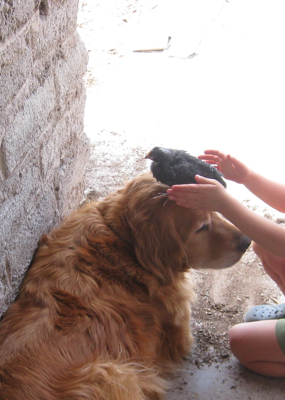
Even With a Mountain Lion Treating My Chickens Like a Take-Out Buffet, I Can Run Up My Canyon Again Thanks to the New Funky Butte Ranch Dog: Meet Golden (Mutual) Rescue Abbie
January 10, 2013
Six Sense Serenade: The Promotion of Now
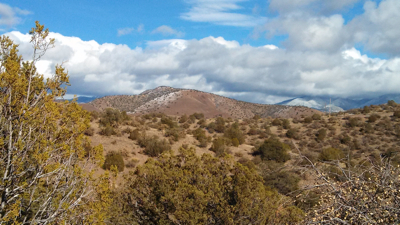
The view from the peak of the Funky Butte Ranch arroyo run about which I’m always blogging on and on, including today
Why on Earth are we here?
Surely not to live in pain and fear.
–J. Lennon
One of the lasting lessons I learned early on my first extended trip into true wilderness (recently and probably soon again to be known as the Planet) — which expedition was a bush plane drop off in a wolf-heavy spot in Western Alaska in 1993 — was that if you are in a mentally and geographically quiet enough place to hear a raven’s wings whooshing, if pretty much means you can only have a good day.
This (in my view) key grounding lesson in any complete education has since been confirmed so many times in the field, across nearly fifty degrees of latitude, that if I had recorded ten percent of the pertinent experiences I could probably have pulled off a Journal of the Hyper Intelligent Bird-sanctioned study. Excluding the odd extreme event which demands a particular parasympathetic nervous system response, you’re in a very desirable space for handling just about anything that comes your way when you’ve not just seen but heard a raven. You’re a conscious member of creation. You’re also probably dozens if not hundreds of miles from the nearest car alarm, law office or pharmaceutical-polluted public water supply.
Here on the Funky Butte Ranch, I’m in danger of taking such days — days featuring low-flying avian-caused audible air — for granted. Days when a hyper-intelligent bird’s wings are not just discernible, are not just loud, if the wind’s right they actually echo off canyon walls. In fact we’re beyond wild wing/wind fugues here. I’m so spoiled in my home and workspace that I’m pretty sure I’ve got one purple-highlighted yearling raven resident of the Ranch ready to perch on my arm. We already have daily extended conversations, usually just after goat milking, when there’s a lot of spilled grain all over the corral, chicken coop, and meadow. I’m trying to teach it, “Howdy neighbor,” and it’s trying to teach me, “Squa-Squawk (throat roll) Squack.” These lessons can go on for some time — it’s the kind of un-rushed chattiness you see at small town deli counters when you’re in a hurry. In fact, being on deadlines short and long, I had to end the last two exchanges.
This is all part of the daily payer that I call my morning arroyo run.
First, a little background about how I came to realize that my gym is also my shrine. The final sprint to that awareness began when I acquired, just last week, Western scientific proof of my long held belief that the main, if not the only error that the human species need correct as of this moment in Gregorian 2013 is giving up hunter/gathering. The moment the first land was fenced off to plant an individual family’s seeds, kings and slaves (and the lawyers, newspapers and priests necessary to keep the insanity in place) were not far behind.
An easy fix, I think. For me, at least. Just do what makes me happy. But I have a finely tuned vibe sensor and I can sense that over the years most folks, if not a super majority, have tended to find my “let’s get back to the wandering” suggestion, which I’ve been making since my early 20s, unrealistic, if not certifiable. Finally I discovered that someone with tenure had long ago signed off on it. The key is for this to happen before the flailing powers make you drink the hemlock. This involves living a life of courageous delicacy. Finding myself still alive, now I have my dinner party (or river raft or green room) back-up! It’s like Idea Insurance.
Comes in the form of a 1965 UC Berkeley doctoral anthropological dissertation in which Richard Lee found that the !Khun people (I think the exclamation point is some kind of click) of the Kalahari average 2,140 calories per day and an astounding 93.1 grams of protein during a – and this is the key stat for this dreamer – 12-19 hour work week. I spend more than that blanching kale.
And this is a non-motorized work week. A work week sans the freakin’ wheel.
I shudder to think what we’d turn up if we studied our own society in these terms. Imagine the relative caloric intake to energy expended of, say, the financial adviser, the Wal-mart regional manager, the GMO corn farmer, the trucker, or you or me.
I know, I know, there’s no going back once we’re in Netflix instant play territory, but a) We can solar-power it all, and b) we can learn from the past.
During my own analog of what Lee describes as the !Kung’s “extended leisure time” each day, I notice that when I’m in an ecosystem that’s alive to the point of healthy predator/prey balance, I remember not just that the universe seems to want what’s best (for me and everyone), but that it’s always acceptable to be my own friend. This restorative is delivered thus far without fail on every 45-minute run/yoga routine in the wilderness adjacent to my ranch. I feel like I’ve won the psychic lottery every day. I wouldn’t change a thing in a life that yet again got me to this point feeling this way. Well, hardly anything.
This is to say that without expectation, conscious need or preparation (beyond some rudimentary Tree Pose stretching in the creekbed) I enjoy a profound spiritual experience while exercising every morning. It just happens. Today the spiritual spark ignited a few nanoseconds after I scooped up a handful of shaded old snow, blindingly white against the cactus and yucca screen, and rubbed it on my sweaty neck. That was when the woodpecker started up in stereo — in an oak tree on either side of the deer trail where I had paused for a sip of water.
Whatever the day’s catalyst (talk about Must See TV), I often find as I duck under the final fence line and see and smell the juniper smoke rising from my own house, that I can’t say thank you enough. To God, the dang in-the-orchard-again goats, everyone. Sometimes it kicks in earlier than others, and can interfere with my ostensible exercise: I keep thinking of something or someone or some kindness for which to give focused, intentional thanks, so I stop for a minute, pull off my headphone, pray, get caught up in a woodpecker symphony, or the deer hoof reverberations of the herd I’ve just startled, or (this one happens a lot in wintertime) a regrouping quail family yipping from trail-side clusters of Apache plume bushes like Sesame Street aliens as the resident red-tail hawk circles languorously overhead, probably assuming I’ve got to that breakfast take-out counter before she has.
I’m the kind of fellow who doesn’t generally expect instant karma. I try to be patient; make an effort not to forget the many-stepped cure when there’s a lag between medicine and healing. But my morning run straightens me out (a lot or a little, as needed) every time. It matters to me a great deal that it never fails. It somehow informs me that the holy is always discernible, like a focus feature, if I just keep groping for the dial. A sweetheart of mine once said she exercised so she could eat. I exercise so I can feel.
The question I faced upon having this realization was, “Do I write about it?” I have no interest in pushing my particular spiritual path. In the end, I just decided to do what I always do: write what I feel. I know I’m fed on one beautiful thought or act per day. I return from the morning arroyo run feeling like the funnest decision, the easiest path, is to try to be the best conscious being possible, and then maybe a little better. Beyond a better writer, a better friend, or even a better father, my exercise routine, I believe, makes me a better rancher. Which, granted, isn’t saying much.
Like a crunchy Elmer Fudd, I’ve been known to guard my goats all night from coyotes with a shotgun I hardly know how to use. This kind of love is acutely recognized by the Funky Butte Ranch livestock, and it is returned in the form of real protein production benefits. I think I’ve probably drank more than a ton of my goats’ growth hormone-free milk in the past half decade.
It’s for all of these reasons that I go, go, always go on that run, even on a subzero morning with a headache on no sleep post-deadline when still jet-lagged from a Szechwan-fueled East Coast media trip. My armor as I glide through this sometimes dangerous world is the magnitude of my appreciation. The more appreciative I am (directly correlated to the more raven wings I hear), the stronger I am — anywhere. Some people say they don’t listen to what today are called “the haters.” I see haters — and there thankfully don’t seem to be many, which is just enough — as part of the love. They provide part of life’s essential humility-maintaining Ninja training. Not just in motivation to prove them wrong but to see if there’s anything to learn in what they say.
“Home again,” I realize one more time, panting from the session’s final sprint (marathon runners know this as “interval training”) as I scritch one of my goats between the horns and start thinking about my work day tasks to do and ranch repair tasks to postpone. “Overflowing with, permeated by, active love and a few cactus thorns (“Ouch” in my ecosystem isn’t so much an exclamation as a figure of speech).” Also more than a little ready for the eggs and the other goodies that the non-human branch of the Funky Butte Family provides. I’m pretty good on protein even if Wal-Mart goes away.
So that’s a source outline, a starter in case Dr. Lee wants to tackle my neo-Rugged Individualist lifestyle. And thus, my run is my prayer. In fact, in rereading the previous paragraph I’m thinking that a more accurate title for this Dispatch might be “Six Sense Marinade.” It just doesn’t take much to launch me into blissful appreciation. I’m a spiritual lightweight — one hour outside and I’m high all day. Regardless of the title, what is without question going on is stimulation of every one of my known senses plus some others I can’t quite name. I’m lumping some very disparate flavors of awareness into a “sixth” sense here, which I’d like to acknowledge just in case, the way string theorists says we’re dealing with, ya know, 42 dimensions or something, we might also be just scratching the surface of perception and indeed consciousness itself. I’m referring to receiving signals as “true” in the same manner that the optical nerves receive “oak” signals when you look at an oak.
The activating agent for this relatively straightforward “There is only Love” message, as I’ve already alluded, is often a windsurfing angel of a raven, who seems to get something out of our Walnut Tree Klatches as well. (Park signs advise us to “leave no trace” in the wilderness. I think we need to add the word “physical”, since I believe we exchange valuable psychic treasures with other travelers, no matter the species, every second we’re on the planet.) This is one reason I think my religion has to happen in a wilderness setting. Another is that, for a guy like me, if he consciously keeps in shape, the kind of physical quiet I’m talking about leaves room for real spiritual growth. At least prioritizing.
I live on Goat Milking O’clock. Mine is a datura based calendar with seasons delineated by owl and falcon fledgling, by when each variety of hummingbird arrives. Once I can see or hear human neighbors, everything changes to Digital Age normalcy. The primate pissing contests over road maintenance and dog etiquette begin. I start caring about cosmically unnecessary things.
Last week one of my neighbors, whose wildfire my ranch sitters rushed to put out while I was researching Too High to Fail, erected an impassable cairn of river stones on the only “road” between “his” property and “mine.” Ostensibly to prevent road creep into his meadow, I would think, but really to stimulate a lot of chimp gesticulating and grunting. I think I’m supposed to move them (a rancher version of the medieval slapping with a glove). I ain’t playing. As yet haven’t even dramatically circled into his Rubicon of a meadow. Just been pushing the Ridiculously Oversized American Truck‘s rear view mirror in and brushing against the poor far side juniper. I have a whole passenger seat full of indigo juniper berries, slowly turning to gin in my rarely vacuumed rig.
Back to prayer mechanics, for a moment, because the whole reason I’m telling all this is that I made a for-me exciting change to one part of it recently that I’d like to share here in a bit. The arroyo run service, as I say, is unscheduled but daily. I say “gotta go pray to stay in shape” in the exact same muscular situation that some would say “gotta go work out to stay in shape.” If it had a printout the service would I think look something like this:
–Run up local Continental Divide canyon with Bob Marley playing in one ear and self-serve woodpecker diner duets in the other.
–Hit imaginary speed bag for one minute, break for one. Repeat until distracted.
–Stop to stretch (Tree Pose and other stretches with Sanskrit names).
–Exclaim something like, “Whoa, listen to that cactus wren call! Thirteen notes! Syncopated quarter notes and triplets in 13/4.”
–Immediately notice a second minor miracle (today it was a hidden, impossibly out-of-season lemoncillo blossom, still redolent of its namesake citrus).
–Notice self feeling, overwhelmingly, bolt-uprightingly, that the Creator of this miracle of life at all, let alone the intense and constant LASER show of conscious being, deserves immediate and intentional appreciation. Specifically, for the gift of the immeasurable love and beauty that surround us at every moment. I mean, this is the giver, to give a recent example, of the din of joyous bee wings half submerged in desert wildflowers. The ancients share the best light show with us: a shooting star, the Northern Lights, the blue tip of a campfire.
Using roughly the above map, I try to ground every element of my life these days in appreciation of the gift of this great, often hysterically-funny adventure of conscious existence in my current body, this puzzle whose goal, rules and every clue seems to me to be “in any situation, a good practice is to try to live closer to heaven”.
That’s it. The above is where my relative sanity resides. That’s the mechanics of it, anyway. Now, for those who believe prayer is the recitation of some kind of hands-folded poem, on to the words. But first, big thanks to Dr. Lee — sending appreciation to you for legitimizing my appreciation. At last I can say with the kind of confidence that only peer-reviewed academic research can provide, that the closer I get to Neolithic lifestyle, the closer to heaven I feel. It might even prove an as-yet unrecognized branch of my faith called “Wildernessism.”
Insofar as I use any consistently articulated human words to express the breadth of my big picture appreciation, for years I have generally uttered, somewhere on my run, this:
“Thank you, God for
Conscious Life,
Love,
Beauty, and
Everything (Note: sometimes I ad lib by tacking on something specific here, like ‘…including the neighbor’s pack of inbred dogs currently menacing me from a few ridges away with their visibly foaming fangs and recent cases of Parvo‘).”
I’ve been gushing forth with that prayer virtually unchanged since at least 1998, when I’d use the break on an icy run with a view of Homer, Alaska’s Kachemak Bay to jam my hands into my armpits. My fingers are just warming back up now. Since last millennium it’d been “Thanks for Life, Love, Beauty and Everything.” Seemed just a bit more rigorous, less lazy, than simply, “Thanks for…it all!” Closest thing to a mantra in my world, at any rate. I could recite it with an empty mind, and mean it. Until last Thursday.
And this change, coming so soon after and even more than Academic Officialdom backing its obvious meaning up, is what made me realize that my run, or more generally being outside somewhere quiet, is the principle practice of my religion. Even on holy fasting days. What happened was I, in short order, both added and then promoted to the anchor position the noun “Now” to this prayer.
So now the morning Appreciation Benediction is, “Thanks for Life, Love, Beauty, Everything and Now.”
I knew right away that the word was in the picture forever. It’s a good word. A metaphor made for the universality of prayer. For why it feels like to me that we are here.
I congratulated it, and, a few days later I started ending with it. When Now debuted (in retrospect, it had been a rising prospect developing in the minors for years), I was up to the “stop to stretch” stage in the above service and recall that one of the morning’s minor miracles had been that the only other tracks before mine in an overnight snow dusting were clearly some kind of not-small wildcat.
Some scat further up my creekbed confirmed this bit of very amateur tracking. I checked my phone reception in case I survived the initial claw-to-jugular in strong enough shape to call 911, made a note that I had just added “Now” in my longest-running, Cal Ripkin of a prayer, and, momentarily blinded as the first rays of winter sunshine beamed over the Eastern ridges of my canyon like oncoming high beams, bolted in undignified fashion along the deer trail until I was in what felt to me a less exposed position. This is when I acquired most of the day’s desert acupuncture needles. In other words, terrifying wildcat tracks are, particularly after the fact, why I live remote.
Not more than five days later, in nearly the same spot and on cue, I felt the appreciation coming on as I spied the spine of the Continental Divide and nearly wept for joy at its meaning: that I felt that such a wild friggin’ place was home base. Boom. Closed with “Now” and don’t see that changing for a long time. For one thing, being thankful for the Now always applies. Thus it’s much more elegant and way simpler than every time slipping in some wordy if accurate in-the-moment analogue, like, “Thanks for the absolutely distinct quiet of a snowy high desert canyon morning in January, which sounds like nothing else I can name except maybe a whisper inside some kind of soundproof organic recoding studio: even the echoes of Cambrian rocks sliding down the arroyo under my bootsoles tone it down after a winter Land of Enchantment snowstorm and this is so sublime that I don’t know whether to bust out in giggles or fall to the ground in gratitude that I’m allowed to feel this way. Which feeling I don’t want to stop. Ever. The world as it was given is a spiritual chiropractor. Real quiet is loud. Almost conscious. It allows me to breathe deeply (a very important health maintenance practice) without distraction. “
I patted Now on the shoulder and told it, “You’ve got the job, kid.”
* * * * *
A few work (Drug Peace) Postscripts (in writing the joy-filled Afterword to the paperback edition of Too High to Fail last week, I realized with some surprise that I’ve essentially been a full time drug policy journalist for two years now): Thanks to the Melissa Harris-Perry Show (which is staffed with smart and kind producers and host) for the fun recent panel discussion on MSNBC. Here’s a behind-the-scenes tidbit: I and the other panelists got to intensely lobby fellow panelist Congresswoman Loretta Sanchez (D-CA) to introduce legislation to get cannabis out of federal Controlled Substances Act. For the good of the country.
I’m also delighted to send ecstatic props to the Mendocino County, California county government for fighting an unconstitutional and privacy violating federal subpoena surrounding the successful cannabis permitting “Zip-tie” program I followed in Too High to Fail. As much as this is great for America’s freedom, economy, pubic health and community safety, I’m just astounded after two decades of journalism to come across a functional local government. The elected officials in Mendocino’s Board of Supervisors, folks who hold widely disparate views on everything from cannabis to the age of the universe, unified and decided to defend the county’s wise decision to acknowledge and bring above ground the $6 billion-a-year local cannabis industry. We’ll follow progress on the subpoena fight here in these Dispatches. The outcome might well decide whether a sustainable cannabis industry will be born with the dawn of the Dug Peace Era. This is something I wrote about recently on Alternet.
Finally — and from a protein and ice cream perspective most importantly — I’m very pleased to report that the annual Funky Butte Ranch goat breeding adventure is over and I’ve commenced pampering my pregnant, floppy-eared, white-and-brown Nubian Bette. She’s foraging for at least two (and as many as four) now. Of course, the others have noticed. So. Extra treats for all.
I’ll end with a photo from Seattle on what I hope most readers will recognize was an important day in American history: December 6, 2012 (the day the state of Washington’s cannabis legalization went into effect). Though some of the opacity in this photo might be considered atmospheric, the Associated Press reported that there was “nary a police officer in sight” at the massive smoke-out beside the Space Needle that day. America is stronger and safer with the coming of the Drug Peace Era.
Six Sense Serenade: The Promotion of Now
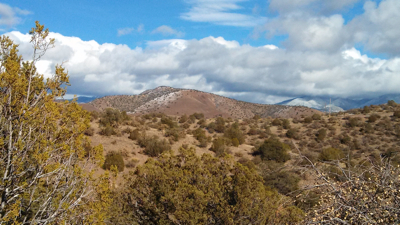
The view from the peak of the Funky Butte Ranch arroyo run about which I’m always blogging on and on, including today
Why on Earth are we here?
Surely not to live in pain and fear.
–J. Lennon
One of the lasting lessons I learned early on my first extended trip into true wilderness (recently and probably soon again to be known as the Planet) — which expedition was a bush plane drop off in a wolf-heavy spot in Western Alaska in 1993 — was that if you are in a mentally and geographically quiet enough place to hear a raven’s wings whooshing, if pretty much means you can only have a good day.
This (in my view) key grounding lesson in any complete education has since been confirmed so many times in the field, across nearly fifty degrees of latitude, that if I had recorded ten percent of the pertinent experiences I could probably have pulled off a Journal of the Hyper Intelligent Bird-sanctioned study. Excluding the odd extreme event which demands a particular parasympathetic nervous system response, you’re in a very desirable space for handling just about anything that comes your way when you’ve not just seen but heard a raven. You’re a conscious member of creation. You’re also probably dozens if not hundreds of miles from the nearest car alarm, law office or pharmaceutical-polluted public water supply.
Here on the Funky Butte Ranch, I’m in danger of taking such days — days featuring low-flying avian-caused audible air — for granted. Days when a hyper-intelligent bird’s wings are not just discernible, are not just loud, if the wind’s right they actually echo off canyon walls. In fact we’re beyond wild wing/wind fugues here. I’m so spoiled in my home and workspace that I’m pretty sure I’ve got one purple-highlighted yearling raven resident of the Ranch ready to perch on my arm. We already have daily extended conversations, usually just after goat milking, when there’s a lot of spilled grain all over the corral, chicken coop, and meadow. I’m trying to teach it, “Howdy neighbor,” and it’s trying to teach me, “Squa-Squawk (throat roll) Squack.” These lessons can go on for some time — it’s the kind of un-rushed chattiness you see at small town deli counters when you’re in a hurry. In fact, being on deadlines short and long, I had to end the last two exchanges.
This is all part of the daily payer that I call my morning arroyo run.
First, a little background about how I came to realize that my gym is also my shrine. The final sprint to that awareness began when I acquired, just last week, Western scientific proof of my long held belief that the main, if not the only error that the human species need correct as of this moment in Gregorian 2013 is giving up hunter/gathering. The moment the first land was fenced off to plant an individual family’s seeds, kings and slaves (and the lawyers, newspapers and priests necessary to keep the insanity in place) were not far behind.
An easy fix, I think. For me, at least. Just do what makes me happy. But I have a finely tuned vibe sensor and I can sense that over the years most folks, if not a super majority, have tended to find my “let’s get back to the wandering” suggestion, which I’ve been making since my early 20s, unrealistic, if not certifiable. Finally I discovered that someone with tenure had long ago signed off on it. The key is for this to happen before the flailing powers make you drink the hemlock. This involves living a life of courageous delicacy. Finding myself still alive, now I have my dinner party (or river raft or green room) back-up! It’s like Idea Insurance.
Comes in the form of a 1965 UC Berkeley doctoral anthropological dissertation in which Richard Lee found that the !Khun people (I think the exclamation point is some kind of click) of the Kalahari average 2,140 calories per day and an astounding 93.1 grams of protein during a – and this is the key stat for this dreamer – 12-19 hour work week. I spend more than that blanching kale.
And this is a non-motorized work week. A work week sans the freakin’ wheel.
I shudder to think what we’d turn up if we studied our own society in these terms. Imagine the relative caloric intake to energy expended of, say, the financial adviser, the Wal-mart regional manager, the GMO corn farmer, the trucker, or you or me.
I know, I know, there’s no going back once we’re in Netflix instant play territory, but a) We can solar-power it all, and b) we can learn from the past.
During my own analog of what Lee describes as the !Kung’s “extended leisure time” each day, I notice that when I’m in an ecosystem that’s alive to the point of healthy predator/prey balance, I remember not just that the universe seems to want what’s best (for me and everyone), but that it’s always acceptable to be my own friend. This restorative is delivered thus far without fail on every 45-minute run/yoga routine in the wilderness adjacent to my ranch. I feel like I’ve won the psychic lottery every day. I wouldn’t change a thing in a life that yet again got me to this point feeling this way. Well, hardly anything.
This is to say that without expectation, conscious need or preparation (beyond some rudimentary Tree Pose stretching in the creekbed) I enjoy a profound spiritual experience while exercising every morning. It just happens. Today the spiritual spark ignited a few nanoseconds after I scooped up a handful of shaded old snow, blindingly white against the cactus and yucca screen, and rubbed it on my sweaty neck. That was when the woodpecker started up in stereo — in an oak tree on either side of the deer trail where I had paused for a sip of water.
Whatever the day’s catalyst (talk about Must See TV), I often find as I duck under the final fence line and see and smell the juniper smoke rising from my own house, that I can’t say thank you enough. To God, the dang in-the-orchard-again goats, everyone. Sometimes it kicks in earlier than others, and can interfere with my ostensible exercise: I keep thinking of something or someone or some kindness for which to give focused, intentional thanks, so I stop for a minute, pull off my headphone, pray, get caught up in a woodpecker symphony, or the deer hoof reverberations of the herd I’ve just startled, or (this one happens a lot in wintertime) a regrouping quail family yipping from trail-side clusters of Apache plume bushes like Sesame Street aliens as the resident red-tail hawk circles languorously overhead, probably assuming I’ve got to that breakfast take-out counter before she has.
I’m the kind of fellow who doesn’t generally expect instant karma. I try to be patient; make an effort not to forget the many-stepped cure when there’s a lag between medicine and healing. But my morning run straightens me out (a lot or a little, as needed) every time. It matters to me a great deal that it never fails. It somehow informs me that the holy is always discernible, like a focus feature, if I just keep groping for the dial. A sweetheart of mine once said she exercised so she could eat. I exercise so I can feel.
The question I faced upon having this realization was, “Do I write about it?” I have no interest in pushing my particular spiritual path. In the end, I just decided to do what I always do: write what I feel. I know I’m fed on one beautiful thought or act per day. I return from the morning arroyo run feeling like the funnest decision, the easiest path, is to try to be the best conscious being possible, and then maybe a little better. Beyond a better writer, a better friend, or even a better father, my exercise routine, I believe, makes me a better rancher. Which, granted, isn’t saying much.
Like a crunchy Elmer Fudd, I’ve been known to guard my goats all night from coyotes with a shotgun I hardly know how to use. This kind of love is acutely recognized by the Funky Butte Ranch livestock, and it is returned in the form of real protein production benefits. I think I’ve probably drank more than a ton of my goats’ growth hormone-free milk in the past half decade.
It’s for all of these reasons that I go, go, always go on that run, even with a headache on no sleep post-deadline when still jet-lagged from a Szechwan-fueled East Coast media trip. My armor as I glide through this sometimes dangerous world is the magnitude of my appreciation. The more appreciative I am (directly correlated to the more raven wings I hear), the stronger I am — anywhere. Some people say they don’t listen to what today are called “the haters.” I see haters as part of the love. They provide part of life’s essential humility-maintaining Ninja training. Not just in motivation to prove them wrong but to see if there’s anything to learn in what they say.
“Home again,” I realize one more time, panting from the session’s final sprint (marathon runners know this as “interval training”) as I scritch one of my goats between the horns and start thinking about my work day tasks to do and ranch repair tasks to postpone. “Overflowing with, permeated by, active love and a few cactus thorns (“Ouch” in my ecosystem isn’t so much an exclamation as a figure of speech).” Also more than a little ready for the eggs and the other goodies that the non-human branch of the Funky Butte Family provides. I’m pretty good on protein even if Wal-Mart goes away.
So that’s a source outline, a starter in case Dr. Lee wants to tackle my neo-Rugged Individualist lifestyle. And thus, my run is my prayer. In fact, in rereading the previous paragraph I’m thinking that a more accurate title for this Dispatch might be “Six Sense Marinade.” It just doesn’t take much to launch me into blissful appreciation. I’m a spiritual lightweight — one hour outside and I’m high all day. Regardless of the title, what is without question going on is stimulation of every one of my known senses plus some others I can’t quite name. I’m lumping some very disparate flavors of awareness into a “sixth” sense here, which I’d like to acknowledge just in case, the way string theorists says we’re dealing with, ya know, 42 dimensions or something, we might also be just scratching the surface of perception and indeed consciousness itself. I’m referring to receiving signals as “true” in the same manner that the optical nerves receive “oak” signals when you look at an oak.
The activating agent for this relatively straightforward “There is only Love” message, as I’ve already alluded, is often a windsurfing angel of a raven, who seems to get something out of our Walnut Tree Klatches as well. (Park signs advise us to “leave no trace” in the wilderness. I think we need to add the word “physical”, since I believe we exchange valuable psychic treasures with other travelers, no matter the species, every second we’re on the planet.) This is one reason I think my religion has to happen in a wilderness setting. Another is that, for a guy like me, if he consciously keeps in shape, the kind of physical quiet I’m talking about leaves room for real spiritual growth. At least prioritizing.
I live on Goat Milking O’clock. Mine is a datura based calendar with seasons delineated by owl and falcon fledgling, by when each variety of hummingbird arrives. Once I can see or hear human neighbors, everything changes to Digital Age normalcy. The primate pissing contests over road maintenance and dog etiquette begin. I start caring about cosmically unnecessary things.
Last week one of my neighbors, whose wildfire my ranch sitters rushed to put out while I was researching Too High to Fail, erected an impassable cairn of river stones on the only “road” between “his” property and “mine.” Ostensibly to prevent road creep into his meadow, I would think, but really to stimulate a lot of chimp gesticulating and grunting. I think I’m supposed to move them (a rancher version of the medieval slapping with a glove). I ain’t playing. As yet haven’t even dramatically circled into his Rubicon of a meadow. Just been pushing the Ridiculously Oversized American Truck‘s rear view mirror in and brushing against the poor far side juniper. I have a whole passenger seat full of indigo juniper berries, slowly turning to gin in my rarely vacuumed rig.
Back to prayer mechanics, for a moment, because the whole reason I’m telling all this is that I made a for-me exciting change to one part of it recently that I’d like to share here in a bit. The arroyo run service, as I say, is unscheduled but daily. I say “gotta go pray to stay in shape” in the exact same muscular situation that some would say “gotta go work out to stay in shape.” If it had a printout the service would I think look something like this:
–Run up local Continental Divide canyon with Bob Marley playing in one ear and self-serve woodpecker diner duets in the other.
–Hit imaginary speed bag for one minute, break for one. Repeat until distracted.
–Stop to stretch (Tree Pose and other stretches with Sanskrit names).
–Exclaim something like, “Whoa, listen to that cactus wren call! Thirteen notes! Syncopated quarter notes and triplets in 13/4.”
–Immediately notice a second minor miracle (today it was a hidden, impossibly out-of-season lemoncillo blossom, still redolent of its namesake citrus).
–Notice self feeling, overwhelmingly, bolt-uprightingly, that the Creator of this miracle of life at all, let alone the intense and constant LASER show of conscious being, deserves immediate and intentional appreciation. Specifically, for the gift of the immeasurable love and beauty that surround us at every moment. I mean, this is the giver, to give a recent example, of the din of joyous bee wings half submerged in desert wildflowers. The ancients share the best light show with us: a shooting star, the Northern Lights, the blue tip of a campfire.
Using roughly the above map, I try to ground every element of my life these days in appreciation of the gift of this great, often hysterically-funny adventure of conscious existence in my current body, this puzzle whose goal, rules and every clue seems to me to be “in any situation, a good practice is to try to live closer to heaven”.
That’s it. The above is where my relative sanity resides. That’s the mechanics of it, anyway. Now, for those who believe prayer is the recitation of some kind of hands-folded poem, on to the words. But first, big thanks to Dr. Lee — sending appreciation to you for legitimizing my appreciation. At last I can say with the kind of confidence that only peer-reviewed academic research can provide, that the closer I get to Neolithic lifestyle, the closer to heaven I feel. It might even prove an as-yet unrecognized branch of my faith called “Wildernessism.”
Insofar as I use any consistently articulated human words to express the breadth of my big picture appreciation, for years I have generally uttered, somewhere on my run, this:
“Thank you, God for
Conscious Life,
Love,
Beauty, and
Everything (Note: sometimes I ad lib by tacking on something specific here, like ‘…including the neighbor’s pack of inbred dogs currently menacing me from a few ridges away with their visibly foaming fangs and recent cases of Parvo‘).”
I’ve been gushing forth with that prayer virtually unchanged since at least 1998, when I’d use the break on an icy run with a view of Homer, Alaska’s Kachemak Bay to jam my hands into my armpits. My fingers are just warming back up now. Since last millennium it’d been “Thanks for Life, Love, Beauty and Everything.” Until last Thursday. Seemed just a big more rigorous, less lazy, than simply, “Thanks for…it all!”
And this change, coming so soon after and even more than Academic Officialdom backing its obvious meaning up, is what made me realize that my run, or more generally being outside somewhere quiet, is the principle practice of my religion. Even on holy fasting days. What happened was I, in short order, both added and then promoted to the anchor position the noun “Now” to this prayer.
So now the morning Appreciation Benediction is, “Thanks for Life, Love, Beauty, Everything and Now.”
I knew right away that the word was in the picture forever. It’s a good word. A metaphor made for the universality of prayer. For why it feels like to me that we are here.
I congratulated it, and, a few days later I started ending with it. When Now debuted (in retrospect, it had been a rising prospect developing in the minors for years),I was up to the “stop to stretch stage” in the above service and recall that morning’s minor miracle had been that the only other tracks before mine in an overnight snow dusting were clearly some kind of not-small wildcat.
Some scat further up my creekbed confirmed this bit of very amateur tracking. I checked my phone reception in case I survived the initial claw-to-jugular in strong enough shape to call 911, made a note that I had just added “Now” in my longest-running, Cal Ripkin of of a prayer, and, blinded as the first rays of winter sunshine beamed over the Eastern ridges of my canyon like oncoming highbeams, bolted in undignified fashion along the deer trail until I was in what felt to me a less exposed position. In other words, terrifying wildcat tracks are why I live remote.
Not more than five days later, in nearly the same spot and on cue, I felt the appreciation coming on as I spied the spine of the Continental Divide and nearly wept for joy at its meaning: that I felt that such a wild friggin’ place was home base. Boom. Closed with “Now” and don’t see that changing for a long time. For one thing, thanking for the Now always applies. Thus it’s much more elegant and way simpler than every time slipping in some wordy if accurate in-the-moment analogue, like, “Thanks for the absolutely distinct quiet of a snowy high desert canyon morning in January, which sounds like nothing else I can name except maybe a whisper inside some kind of soundproof organic recoding studio: even the echoes of Cambrian rocks sliding down the arroyo under my bootsoles tone it down after a winter Land of Enchantment snowstorm and this is so sublime that I don’t know whether to bust out in giggles or fall to the ground in gratitude that I’m allowed to feel this way. Which feeling I don’t want to stop. Ever. It is a spirtual chiropractor.”
A few work (Drug Peace) Postscripts (in writing the joy-filled postscript to the paperback edition of Too High to Fail, I realized I’ve essentially been a full time drug policy journalist for two years now): Thanks to the Melissa Harris-Perry Show for the fun recent panel discussion on MSNBC. Here’s a behind-the-scenes tidbit: I and the other panelists got to intensely lobby fellow panelist Congresswoman Loretta Sanchez (D-CA) to introduce legislation to get cannabis out of federal Controlled Substances Act. For the good of the country.
I’m also delighted to send ecstatic props to the Mendocino County, California county government for fighting an unconstitutional and privacy violating federal subpoena into the successful cannabis permitting “Zip-tie” program I followed in Too High to Fail. As much as this is great for America’s freedom, economy, pubic health and community safety, I’m just astounded after two decades of journalism to come across a functional local government. The elected officials in Mendocino’s Board of Supervisors, folks who hold widely disparate views on everything from cannabis to the age of the universe, unified and decided to defend the county’s wise decision to acknowledge and bring above ground the $6 billion-a-year local cannabis industry. We’ll follow progress on the subpoena fight here in these Dispatches. The outcome might well decide whether a sustainable cannabis industry will be born with the dawn of the Dug Peace Era. This is something I wrote about recently on Alternet.
And both finally and from a protein and ice cream perspective most importantly, I’m very pleased to report that the annual Funky Butte Ranch goat breeding adventure is over and I’ve commenced pampering my pregnant, floppy-eared, white-and-brown Nubian Bette. Shes foraging for at least two (and as many as four) now. Of course, the others have noticed. So. Extra treats for all.
I’ll end with a photo from Seattle on what I hope all will recognize was an important day in American history: December 6, 2012 (the day the state of Washington’s cannabis legalization went into effect). Though some of the opacity in this photo might be considered atmospheric, the Associated Press reported that there was “nary a police officer in sight” at the massive smoke-out beside the Space Needle that day. America is stronger and safer with the coming of the Drug Peace Era.
November 15, 2012
Indigenous Plus Netflix: “It’s Cool Because It’s Old” Also Applies to Plants
Breaking News: My recent Conan O’Brien appearance is airing again on Monday (November 19) – Check it on TBS in your time zone. Helpful and supremely fun but non-mandatory pre-viewing reading: http://amzn.to/SJIs5i
In This Latest Dispatch: Do Washington and Colorado Have You Singing “God Bless America”? You Haven’t Begun to Hear All The Good News: Stanford’s On Board, Tucson’s Mayor’s Chillin’, The Berlin Wall of the Drug War Has Fallen and the Drug Peace Is Nearer Than Even I Realized (And I’m On the Optimistic Side of the Drug Policy Punditsphere).
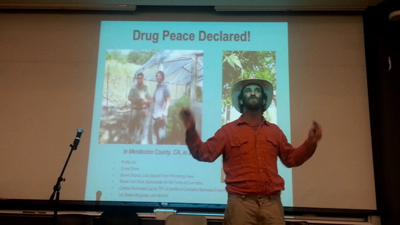 Speaking at the recent Missouri Cannabis Law Reform Conference last week, I learned that the U.S. Heartland is about to end the Drug War along with the rest of the country. It was an honor to appear alongside Drug Policy Alliance founder Ethan Nadelman, and I’m absolutely amazed that the organizers got a presentable photo of me, considering I was wearing not just my previous day’s airplane clothes, but the outfit in which I milked my goats that morning. Had to borrow a toothbrush. Strangely, it kind of makes me nostalgic that airlines can still lose baggage. That’s an analog mode of incompetence. The National Cannabis Coalition’s terrific write-up about the conference is at http://bit.ly/UAufgA
Speaking at the recent Missouri Cannabis Law Reform Conference last week, I learned that the U.S. Heartland is about to end the Drug War along with the rest of the country. It was an honor to appear alongside Drug Policy Alliance founder Ethan Nadelman, and I’m absolutely amazed that the organizers got a presentable photo of me, considering I was wearing not just my previous day’s airplane clothes, but the outfit in which I milked my goats that morning. Had to borrow a toothbrush. Strangely, it kind of makes me nostalgic that airlines can still lose baggage. That’s an analog mode of incompetence. The National Cannabis Coalition’s terrific write-up about the conference is at http://bit.ly/UAufgA
This Dispatch is dedicated River, the 13- or 17-year-old Funky Butte Ranch dog, who sleeps now after a lifelong and joyous battle with coyotes, skunks, and other potential threats to the goats she loved and alongside whom she forever rests. This dog was so revered here that Robin, the Ranch cat, sat beside her freshly covered and wildflower-topped grave for nearly a half hour.
At the peak of my arroyo run up the Funky Butte this morning, I stopped, panting, to do stretches with Sanskrit names pretty much astride the (seen from the thawing sunrise) right cup of the bikini that forms the climactically-appropriate topography immediately surrounding my solar-powered goat ranch. My gaze sloping down involuntarily into the belly dip — a delicately dried wildflower meadow between my canyon and the next — I was startled mid-Tree Pose by a single five point elk trotting along in an almost exaggerated leisurely fashion.
With competition only from my own breathing, each of the thirty or fifty footfalls that made up my soundtrack for maybe half a minute reached me like a tap on the shoulder and then echoed into eternity. In a world where hummingbird wings often provide my alarm clock (these days it’s either that or East Coast media establishments looking for last minute guests on the topic of Drug Peace Astonishment stories), an eight hundred pound quadruped proving that Homo sapien is not the only species enjoying a leisurely jog on a given butte really captures a fellow’s attention at dawn.
Thus far without fail over the course of the seven years I’ve seen more goats per week than humans, these morning escapades into backyard Land of Enchantment wilderness, which include an intricate if creamy UV-protection application ritual, fine tune my spirit back to that sweet psychic setting, “Full-On Optimistic.” But the ol’spirit has, blessedly, needed only the finest of tuning of late.
For one thing, most readers of these Dispatches will already be aware that the Drug Peace movement whose birth I recently chronicled has just enjoyed its most significant legal advance in 80 years. It came at the polls, when Colorado and Washington voters overwhelmingly declared total Drug Peace (by legalizing cannabis for adult use), defying the feds and prompting César Duarte, governor of Mexico’s Chihuahua state, to tell Reuters, “It seems to me that we should move to authorize [cannabis] exports.”
It now looks like at least a half dozen other states will follow suit in the next four years – four (Massachusetts, Rhode Island, Maine and Vermont) are already floating full legalization bills in 2012. America’s worst policy, her longest war, is finally wrapping up. The pundits seizing on the story are discussing what amounts to peace negotiations: will the feds raid? Will they sue? It doesn’t really matter. The American people won. We’re done with 2.3 million Americans in prison, 60,000 Mexicans dead, and losing out on a $40 billion a year agricultural tax base, not to mention a finally viable source of biofuel.
So this is what voting for something feels like.
I love when modern memes and ancient truth join hands for a while. I can’t really explain why, but continuity turns me on. It’s not just for ephemeral “right way to live if we want the species to continue on this planet for a few more generations” reasons, but because aiming for continuity in practice is nearly always also the funnest decision.
I’ve had a number of encounters along these lines lately – witnessing the resurfacing of obvious older truths above the digital age noise as mid-Twentieth-century propaganda fades to the point of reading like satire. A prominent moment occurred as I was blazing West across my home Chihuahuan desert toward the neighboring Sonoran — one of the world’s most stark, beautiful, and abrupt geological transformations — en route to a TOO HIGH TO FAIL Pax Cannabis Tour event in Tucson last week. It was the first day of winter shadows, of “go inside and snuggle by a fire” messages, which, in the name of work commitments, I was forced to ignore.
Somewhere past Benson I started nodding (the cackling stove fire was in my mental sights) and was compelled to stop at a particularly touristy gas station (Southwest kistch style). While waiting in line for the caffeine and bombarded with the images we Aztlanders peddle to outsiders, I reflected, “I love that Kokopelli is a brand.” This ancient imp, I felt, conveys an admirable value system. Better’n Katy Perry. Similar, actually. But somehow more genuine because of his consistency. He’s been a combination of playful, spiritual, musical and horny in this desert for at least three thousand years. You find him etched in the caves that line up with astrologically significant dates. He’s like Rabbi, guru and MC all wrapped in one.
Another, even more common continuity experience I enjoy, usually on my morning run after a high desert monsoon storm, is the one where I stumble upon a shard of household Mimbreno pottery. To its maker, the dull piece of 500-year-old fired clay was of the mundane, coil-layered and unadorned variety that’s cooked the most tea in my canyon over the past 1,400 years. And yet it thrills me to hold the shard in my palm. Of course, if my current neighbor tossed a Wal-Mart mug into this creek bed last week (even though miraculously, it had made the journey all the way from China unbroken), I wouldn’t give it a second look. I’d consider it a contravening of local littering laws. Yet this ancient broken mug, serving the same purpose, is quite simply, Cool Because It’s Old.
This (Cool Because It’s Old) has become something of a mantra to me – but what I’m really saying is something old impresses me, is cool, because it’s enduring.
I’m not thinking just about the value of enduring craftsmanship made from readily available local materials (which is cool enough), but about something that for some reason fills me with an even more acute gladness: the indisputable fact, in my very palm, that people were living similar lives to mine here on the Funky Butte Ranch quite a few centuries ago: the Mimbreno branch of the Anasazi people knew how to make a solid mug to drink this same spectacular aquifer water that I do. They planted the same beans. Strolled the same deer trails, their pace moderated by the same baking sun. OK, I’ve added Netflix to and nearly eliminated hand grain-grinding from the daily routine. But the maker of this mug shard in my palm and I watched the same Supernovae sunrises over this same butte, noticing the same too-recent pile of Mountain lion scat before returning home to the same hugs.
I mention the stimulating and satisfying effects of seeing Cool Old Truths because in such a manner is the oldest human relationship with a plant and the modern one beginning to mesh once again. It’s only been 80 years since official humankind, in one of its least sane decisions, decided to break its relationship off with cannabis, but it’s been a long 80 years. In fact we’re as a species recognizing that it was one of modern society’s biggest mistakes. But like all big mistakes, as Jimmy Cliff reminds us in The Harder They Come, it generally gets redeemed in a big way. Which is to say, the Berlin Wall of the Drug War fell last week.
This is the paragraph where, in noting the 10,000-year human relationship with the cannabis plant, which Michael Pollan calls a co-evolution, and which includes multiple cannabis remedies in the oldest surviving medical handbook (from China 3,000 years ago) and, famously, the paper of choice for Thomas Jefferson’s draft of the Declaration of Independence, I’m supposed to also be the cynical seasoned journalist. It’s hip to hype the fact that cannabis, like aspirin and wine, can be health-maintaining if used in moderation, and dangerous if abused. So noted, if not hyped. Writing only about abuse would be like covering the history of baseball and only covering the 1919 Black Sox scandal.
Bigger picture, because I think a lot about what I call The Indigenous Gene and what kind of air, water and overall public safety situation I might be bestowing on my mini-mes, I’m elated by recent Drug Peace progress at the societal level: my family is safer thanks to the voters of Colorado and Washington. TOO HIGH TO FAIL details the massive, aerial federal raid on my closest neighbor, a retiree who self-medicated with cannabis for anxiety before New Mexico’s medical cannabis program started up, that inspired me seek out an alternative to the Drug War and write a book about it. Instead of my usual hummingbird wing alarm clock, I awoke one morning to the climactic scene in Goodfellas: automatic weapons in my creek bed, helicopters close overhead. It genuinely put my kids at risk. Plus it cost you and me easily a million bucks (my neighbor never spent a second in jail for his eleven plants). The whole morning was terrorizing. At first I thought I was in trouble for a petition I had signed against fracking. Meanwhile, the mayor of a nearly town operated unmolested for another two years as a full-fledged cartel member, dispatched to transport American guns south of the nearby border. America’s longest war is her worst social policy since segregation, and it’s embarrassingly ineffective. It’d be one thing if it was a bad policy that worked. The good news is that America’s #1 crop will bring in $40 billion a year when federal cannabis prohibition ends.
Inter-generational Continuity is always on my mind, and no more so than after Tuesday’s election. I knew it was big, world-reverberatingly big, when a reporter from a weekly in Portugal called asking if I was aware that the American election had just ended the international Drug War. This a drug beat reporter in a country which has famously and successfully decriminalized all drugs, even the dangerous ones. (The Australian government is subsidizing its industrial cannabis farmers, by the way, which is important, as readers of TOO HIGH TO FAIL will be aware, since cannabis as a biofuel can play a strong role in ending human dependance on petroleum.)
So with my family a notch further from the needless narco violence that caused me to write TOO HIGH TO FAIL in the first place, I’ve uttered a deep sigh and moved on to inter-species continuity. Which is to say, since returning from Tucson I’ve been actively trying to teach the resident Funky Butte Ranch ravens to say, “Howdy, Neighbor.” I’d like to pass a song down to my descendents here. Here’s why: should the Digital cloud ever give out, multi-generational bird hard drives might prove the most durable. As far as I know, no consumer computer magazine rates products in what I think of as a “will I be able to access this info in 100 years?” category.
Plus, proving again that the continuity-minded choice (often referred to as the sustainable one) is also the aesthetic one, the raven fledglings currently courting and Synchronized Dive Dancing now, when they catch the canyon sunlight, emit a shimmery purple sheen that I’ve never seen anywhere else.
In the convective afternoon at this time of year, the usually eye-opening whumping of enraptured raven wings (as the birds in question emerge from my compost pile toting avocado pits) has competition from cactus wren soloists and the woodpeckers who seem to be gorging to a very slow metronome in every black walnut tree. While I and both my sons sing in an actually almost avian-sounding trio to impart the linguistics lesson, I bask in the thought of the Drug Peace Dividend.
Beyond the $40 billion tax boon to the above ground economy, there’s the end of the cannabis stigma on the horizon. I’m reflecting that, after I escaped the Kokopelli Factory on the recent Arizona tour leg, Tucson Mayor Jon Rothschild did more than introduce my event at the Botanical Gardens sunset speakers series that night. He stayed the whole time, through the Q & A. Indeed he appeared to have the giggles, and didn’t flinch when I urged him to make sure local and state law enforcement support Tucson’s terrific medical cannabis providers. Here we are enjoying a smile.
Border mayors usually get it. But what Tuesday’s election showed is that the nation at large (and indeed judging by the above mentioned international reactions, the world) is finally ready end the Drug War. To win it. More Coloradans voted for cannabis November 6 than voted to re-elect President Obama. Unity on the Drug Peace is unprecedented in recent American public opinion, is increasingly strong, and, as I’ve detailed in previous Dispatches, comes from all sides of the political spectrum. Even Arkansans nearly passed medical cannabis last week, the first Southern state in which voters (bravely) put the issue on the ballot (despite almost no money for the campaign and massive efforts to throw up legal obstacles to the will of the people): that one only lost 52-48%. Just wait until next time, Ozarks — you guys are AWESOME! Thanks for showing America that the heartland is ready to bring on the Drug Peace Era for the good of our nation’s economy and her families.
The Tucson event was (in retrospect unsurprisingly) well-catered. ”We’re not that Arizona,” the terrific operator of a local woman-owned medical cannabis club told me during our interview on her couch-side radio show during that too-short visit. As a New Mexican, crossing into Sheriff Joe’s state is generally like Mrs. Frisby walking past the farm cat. But I’m learning to consider Tucson, once inside city limits, to be an extension of Land of Enchantment home base. Like Rivendell. Terrific sushi, actually, there. It’s a town in which I have a hard time getting out of my sandals. Every time I look down, there are my toes. Interviews, live events. It’s just not a loafers or even a hiking boots town.
What will probably be the long-term take-away for me from this wonderful week of electoral news was hammered home when a producer at CONAN called to let me know that my recent appearance would be airing again in repeats this Monday (November 19). My first reaction, which might have been interpreted by the producer as some sort of raven call, was, “Wow, two months ago I told the host and audience, mid-segment, that I was surprised I was allowed to speak the truth about America’ Longest War without the studio exploding, and now the Drug War’s all but over.” That, in fact, was the moment when I realized that this was the most important week in Drug Policy in 80 years.
So important, so game changing and irreversible is this victory, that some of us still-lucky-to-live-in-a-democracy Americans find ourselves almost unable to grasp what a giant leap closer we are to enjoying the substantial peace dividend of this war’s hostilities ending (and on our best-case terms). One colleague called me from Colorado a week after the election to say, “It just hasn’t sunk in yet. We’ve won!” When enough of your allies (those actually in the industry, and thus even more connected to these votes than I, who merely write about it) are resigned to be criminals forever for insane and harmful reasons, and you hear “it’ll never happen” enough times, well, you understand why this is Happiest News Story I’ve Seen In Years (excerpted from The Daily Chronic, November 9).
 King County, Washington prosecutor Dan Satterberg is treating (the state’s) I-502 (ballot initiative) as if it is already law, dismissing 175 marijuana misdemeanor possession cases on Friday because “it’s the right thing to do.”
King County, Washington prosecutor Dan Satterberg is treating (the state’s) I-502 (ballot initiative) as if it is already law, dismissing 175 marijuana misdemeanor possession cases on Friday because “it’s the right thing to do.”
Satterberg said his office is dropping the cases involving people 21 and older and possession of one ounce or less. Although the law doesn’t take effect until December 6, his office has decided to apply I-502 retroactively, saying it is the right thing to do in light of Tuesday’s vote.
“Although the effective date of I-502 is not until December 6, there is no point in continuing to seek criminal penalties for conduct that will be legal next month,” Satterberg said.
The photo alone might be the finest piece of visual journalism I’ve witnessed in my adult life. In the end, I think we won because the Drug War, like all wars and despite the horrors to innocents and combatants alike, is an idea war. It comes to have very clear, very old-school, almost storybook Good Guy and Bad Guy ideologies. We can usually agree after the fact which side was the aggressor. This is because the truth, unlike a genie, can’t be bottled up, because it seeps out like fragrant terpenes from a pepper plant on a simmering stove pot. Simply because they’re on the side of right, the good guys still pull off these almost unimaginable upset victories. There’s George Washington, Ali, Joe Namath, and the Drug War. And it is, when it comes to the coming Drug Peace Era, and as as Albert Einstein said all truths must be, comprehensible to a four-year-old.
The wisdom of four-year-olds is on my mind, because mine just helped me build a rock wall beneath the goat corral gate this afternoon, ensuring that our chickens and ducks can no longer make it (and the hay and grain therein) their winter home. After he carried and fitted the final mid-size piece of Cambrian sandstone to complete the project, my replicant brushed his hands together. “There,” he said. “If they can still get in now, they deserve it.” Indeed, this is the case with American Drug Policy: if you can work for four decades, as many activists I’ve met in the course of researching TOO HIGH TO FAIL have, against unlimited funding and shameless propaganda, you’re probably on the side of karmic right and deserve to win.
Postscript: I realize with some delight that 2013 marks the commencement of my Not Sure If I Can Call Myself a Stanford Professor Tour. I’m doing two seminars for the Stanford School of Continuing Education, and will be on the road on and off for much of the year. Shoot me an email if you’d like to book an event.
 Lucy Liu checking out TOO HIGH TO FAIL on CBS’ new hit show Elementary last week. Now I’m waitin’ for the American Express spot offer: “When I’m in Colorado or Washington, I don’t always have cash.”
Lucy Liu checking out TOO HIGH TO FAIL on CBS’ new hit show Elementary last week. Now I’m waitin’ for the American Express spot offer: “When I’m in Colorado or Washington, I don’t always have cash.”
Just as Borges believes that every moment of past, present and future is mobile and in fact interchangeable, so I recognize the symmetry embedded in the reality that just two months ago I marveled, mid-segment, that ”the studio didn’t explode” as I discussed the Drug Peace Dividend on national TV. Today, with the CONAN segment in question about to appear in reruns, the Drug War is nearly over.
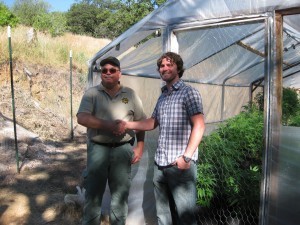 This, for me, is the key TOO HIGH TO FAIL photo that shows that Drug Peace has been declared in northern California: what you’re seeing is Mendocino County law enforcement officer Randy Johnson and sustainable locavore cannabis farmer Tomas Balogh at a farm inspection. It’s also reminder that despite my waltzing into the victory parade behind millions of drum masters, every cannabis farmer who spoke to me with his or her real name in TOO HIGH TO FAIL is still a civil disobedient, as are patients who use credit cards for their medicine. Nearly 800,000 Americans were arrested for cannabis last year. Let’s end this nonsense once and for all: tell your congressperson to remove cannabis from the Controlled Substances Act and let states regulate like alcohol.
This, for me, is the key TOO HIGH TO FAIL photo that shows that Drug Peace has been declared in northern California: what you’re seeing is Mendocino County law enforcement officer Randy Johnson and sustainable locavore cannabis farmer Tomas Balogh at a farm inspection. It’s also reminder that despite my waltzing into the victory parade behind millions of drum masters, every cannabis farmer who spoke to me with his or her real name in TOO HIGH TO FAIL is still a civil disobedient, as are patients who use credit cards for their medicine. Nearly 800,000 Americans were arrested for cannabis last year. Let’s end this nonsense once and for all: tell your congressperson to remove cannabis from the Controlled Substances Act and let states regulate like alcohol.
October 15, 2012
America Adapts: The Drug Peace Transition Looks to Be a Smooth One
Conan’s on Board (along with Pat Robertson and Ronald Reagan’s Secretary of State George Shultz)
Best of all, well, there’s nothing like a 30 minute television interview conducted by the people about whom you’ve just written a major book. From the heart of the Emerald Triangle, I actually had Mendocino sand in my toes during this fun and revealing interview conducted by quite the knowledgeable host.
Enhanced, I’m sure, by my suffusion this morning in a color I call “high desert purple at 5,700 feet as refracted off the crystals of billion-year-old Cambrian sandstone when confronted with the first rays of an October sunrise” (when I want to be humbled I talk to a geologist), I notice again that even (especially?) the most harried departure sequences from the Funky Butte Ranch invariably prove to be such profoundly sacred experiences. And not just because I was out of organic roiboos tea.
An inveterate questioner, a seeker of source, I somehow every time accept these staggeringly sublime morning services, these special effects-driven atmospheric panoramas, without surprise or question, perhaps because I’ve given myself four hours and five minutes to make a flight at an airport four hours away. Per ritual, I stop the Ridiculously Oversized American Truck thirty feet from where I’ve started it to issue some good-bye scritches to the foreheads of the goats that provide my protein in fact my road food menu this morning is a very civilized one:
DESAYUNO de FUNKY BUTTE
–Organic stoned wheat crackers
–Grapes
–Last of the roiboos
–Jugo de naranjo con aceite de hemp
–Possibly a few Green and Black’s 80% cacao organic chocolate squares in the center console (gotta remember to check before the sun gets too high and melts the dash, let along anything stored in it).
I know the mechanical requirements of this putative repast are going to be causing some grand parabolic swerving as I traverse the first of my two mountain ranges in about twenty minutes (texting-while-driving has been banned before assembling-muti-layered-locavore-snacks-while-driving, possibly because the only witnesses to the latter are generally fox and elk).
For now, though, I hear myself saying “Good bad goat” to caprine grandmother Natalie as her front hooves, on cue, curl up and over my truck bed in her abortive but paint-scratching attempt to come along as tour road manager. A bipedal goat meeting my circular pupils with her horizontal slits always makes me laugh. Ah, I see the ducks and chickens have layed their eggs in a lotus-like star this morning, all within a single nest.
My last vista before I hit pavement in a cloud of kung pao-chicken scented vegetable oil exhaust includes two courting ravens dive-bombing (and by the narrowest of last second updraft margins avoiding) my rooftop solar panels. Now I must transition once again from chicken egg gathering to sushi order picking-up. I feel prepared.
With fourteen hours before my next event in San Francisco, I find myself reflecting with immense gratitude on my role as broadcaster to mainstream tipping point audiences (albeit in my particular, ya know, comedic investigative voice) of a message that others have been preaching for four decades.
What I’ve come to realize palpably is that when you speak for a genuine slice of change matters. When you thrown down and join the battle. Do it too early and your role might be rhetorically powerful, even a valuable and commemorated skirmish in the larger war, but it might cost you little things like your freedom, your livelihood, your home, your family or your life.
The world took notice and took a step toward justice when 12-year-old Pakistani child labor activist Iqbal Masih was murdered in 1995. But a lot of good that did Iqbal Masih. With attending my kids’ retirement parties as a goal, let me tell you I’m thankful the universe has set things up so that I am writing about the coming Drug Peace era when support for ending the intervening Drug War is at 56% in the U.S. and climbing, and Pat Robertson, for crying out loud, is on board. We might even see three states (Washington, Oregon and Colorado) unilaterally end the war on cannabis in a few weeks (most pundits predict one or two of these initiatives will pass, which is a great start, as 17 or 23 more will force Congress to wake up and remove cannabis from the Controlled Substances Act entirely, allowing states to regulate cannabis for adult use like alcohol, thus crippling the cartels and effectively ending the domestic war).
So what I’ve been reflecting on is this: you can be asked to enter at the martyr phase, or you can be part of the procession in the final jubilant parade — in the case of this smashing Drug Peace victory right alongside Ronald Reagan’s Secretary of State George Shultz.
Meanwhile, the Pakistani (and worldwide) child slave labor market continues to make our underwear. Will it ever stop? Maybe. Not not without the courage of people like Iqbal Masih. I think of that kid whenever someone tells me they think I’m brave for having written TOO HIGH TO FAIL in 2012. I’m just waltzing in to the capital to celebrate the peace dividend (which is about $40 billion per year). In my New Mexico food co-op the other day, near the bulk quinoa, a friendly lady told me that again: that my book was courageous. “Maybe in 1985 it’d be brave,” I thought. “A few million Drug War arrests ago.” But all I told her was “Thanks! Let’s end this mistake once and for all.” And I say the same to you. With thanks — as a father and a patriot.
Postscript mid-tour, six days later: I guess I should stop being surprised by this (admittedly, accepting such a promising reality as I’m about to relate for the fourth Dispatch running in times I’m told are troubled is making me increasingly unselfconsciously optimistic in a whole spectrum of societal, spiritual, personal and athletic spheres). But the response I continue to get to TOO HIGH TO FAIL and its “The Drug Peace Is Good for America” message (now from mainstream audiences at literary festivals, high schools, colleges and private/corporate events in addition to the bookstore tour stops and cannabis activist organization events that kicked things off a month ago, and the magnanimous and almost loving response from all media platforms) reminds me again that America Adapts.
That’s what she does. God bless her — this is why we’re so innovative and strong, why I busted out in “God Bless America” in the shower in Portland this morning, despite my decision to sample the locavore restaurant-and-microbrew scene until a few short hours ago. I realize that we as a nation, as a cultural entity, have wisely welcomed cannabis into the fold. Into the 300-year-old bundle containing all the Acceptable Parts of a Successful, Safe, Strong and Family-Friendly America.
Which is to say that I think the Drug Peace tipping point is coming sooner than even many cannabis activists realize (and even in the heartland — go Arkansas voters, and hang tough, Missouri: the National Cannabis Coalition is on the way). Please help bring forth this tipping point whether or not cannabis is in your life at the moment (hopefully in ten years it will at least, in industrially fermented form, provide your fuel — talk about a peace dividend). Call your congressperson and senators and tell them, “For the good of the country’s economy and to cripple the drug cartels, please remove cannabis from the Controlled Substances Act and allow states to regulate the plant like alcohol.”
Telling the TOO HIGH TO FAIL Story at the Drug Peace’s Literary Headquarters: Mendocino County’s Gallery Books
Doug Fine's Blog
- Doug Fine's profile
- 14 followers


